Charles of Valois is the son of Catherine de Medici. Mistresses of old times
I will touch lightly on people who did not directly belong to this family, but who are not at all alien to it. The people who surrounded the first representative of this family to ascend the French royal throne - Catherine de Medici.
I remind you that my notes are just a wandering through the pages of Wikipedia - not claiming anything other than the sole purpose - to collect accessible portraits of the Medici, those in whom their blood flowed as closely as possible, and those who were in lifetime communication with them through was in different circumstances.
The history of this genus, in the person of its individual representatives, is so eventful and interesting that even a superficial acquaintance already ignites the blood and awakens the imagination... You don’t need to read any novels - check out real stories lives... A lot of passion and a lot of actions, dictated not only by political and economic benefits, but also by the vivid feelings of people who are accustomed to achieving what they want at any cost...
In general - rich in characters Italian history, the maximum human individuality was revealed in them - as in good deeds, and in the evil ones. And do not divide its heroes by black and white flowers, because their abilities in any matter reached the maximum possible flowering, and one and the same person was capable of the most tender and devoted love, and of dirty betrayal...
1. Henry II(March 31, 1519, Saint-Germain Palace - July 10, 1559, Paris) - King of France from March 31, 1547, second son of Francis 1 from his marriage to Claude of France, daughter of Louis 12, from the Angoulême line of the Valois dynasty. Husband of Catherine de Medici. 25th King of France.
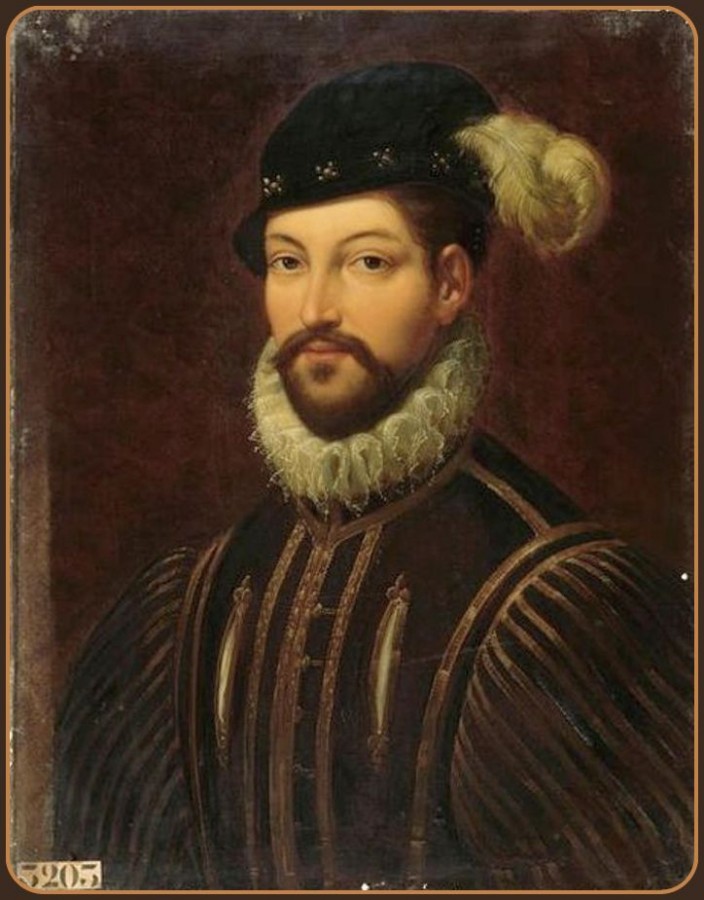
2. Gabriel I de Montgomery, senor de Ducy d'Exmes and de Lorges, count (1530, Ducie - 1574) - Norman aristocrat, involuntary killer of King Henry II. The duel between Montgomery and the king was the last in the history of European knightly tournaments. The absurd death of Henry was the formal reason for their ban. Catherine hated him and in the end managed to send him to the chopping block.
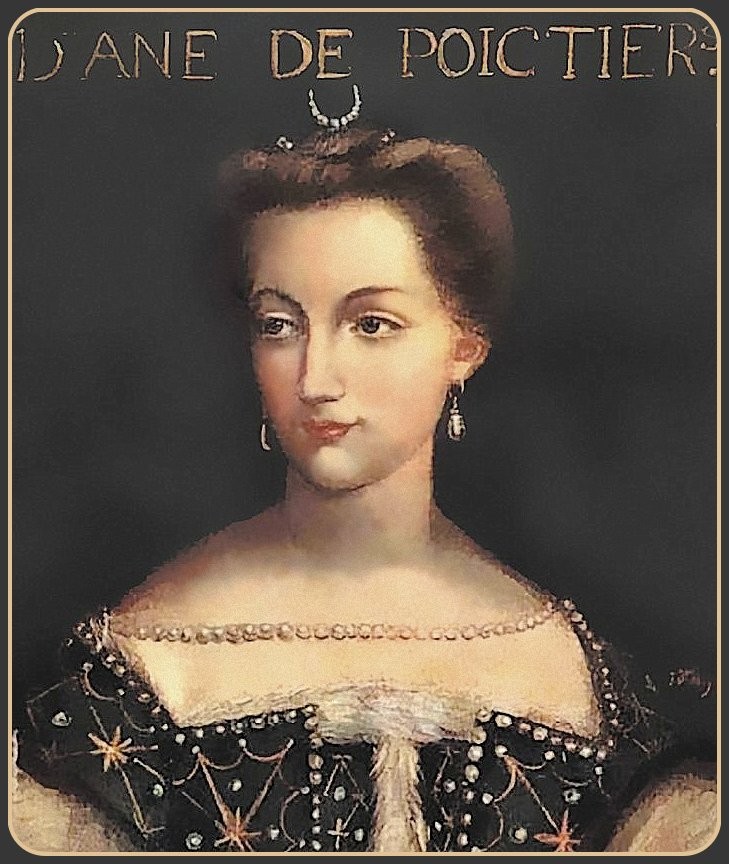
3. Diane de Poitiers(1499 - 1566) - beloved and official favorite of King Henry II.
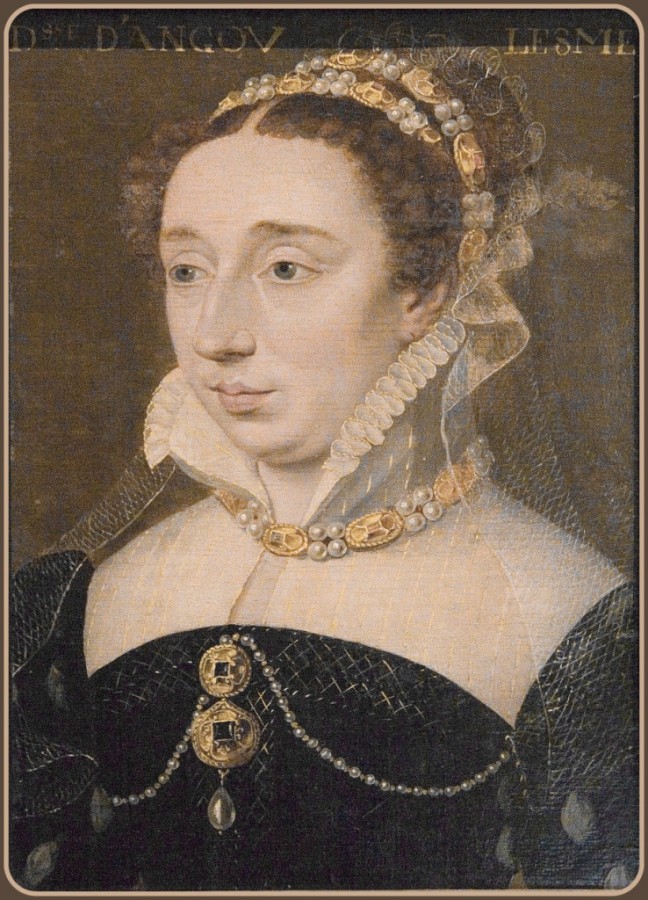
4. Diana of France(July 25, 1538 - January 11, 1619) - illegitimate (legitimized) daughter of the French king Henry II. She bore three ducal titles - duchess of Chatellerault, Etampes and Angoulême. She was the illegitimate daughter of the Dauphin Henry (the future King Henry II) and Philippa Duci from Piedmont. Diana was raised by King Henry's favorite, Diana de Poitiers, and this gave reason to believe that the girl was the king's daughter from her. This is what Brant thought, for example. Diana received a proper upbringing: she knew several languages (Spanish, Italian and Latin), played several musical instruments and danced well.
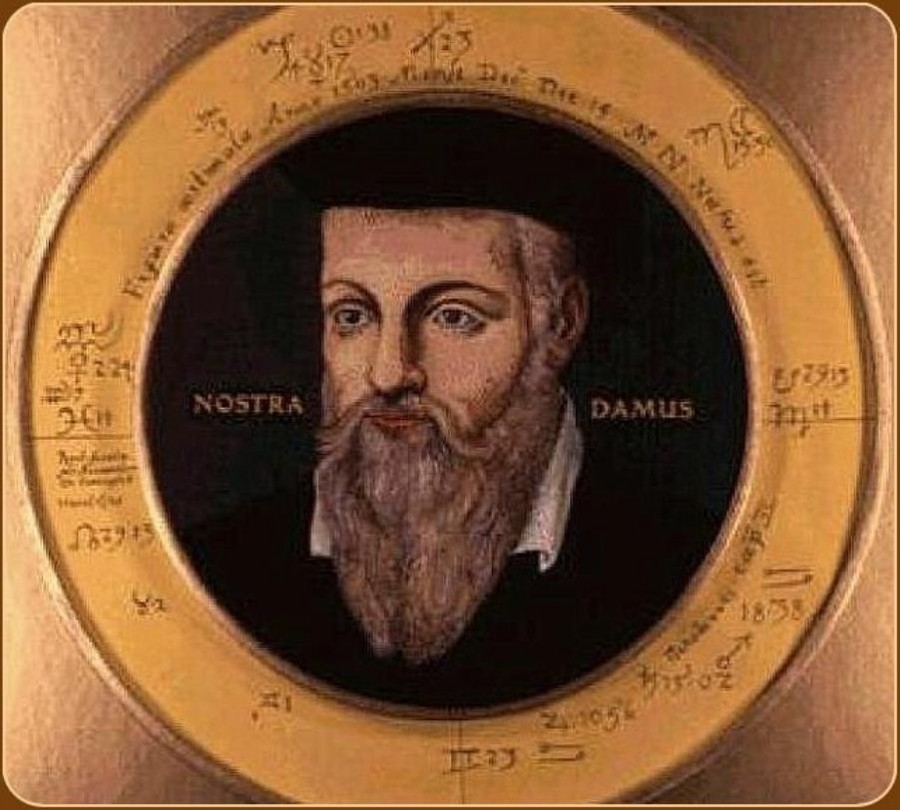
5. Michel de Nostredame, also known as Nostradamus (December 14, 1503 – July 2, 1566) was a French astrologer, physician, pharmacist and alchemist, famous for his prophecies.
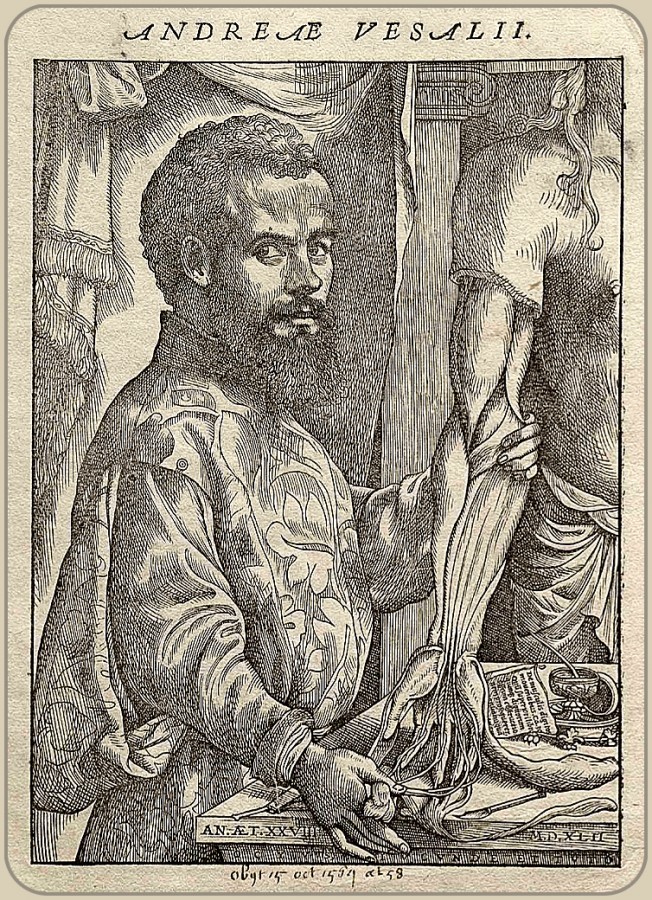
6. Andreas Vesalius(December 31, 1514, Brussels, Seventeen Provinces - October 15, 1564, Zakynthos, Venetian Republic) - doctor and anatomist, physician to Charles V, then Philip II. A younger contemporary of Paracelsus, the founder of scientific anatomy. Tried to save the wounded man at the tournament of Henry II.
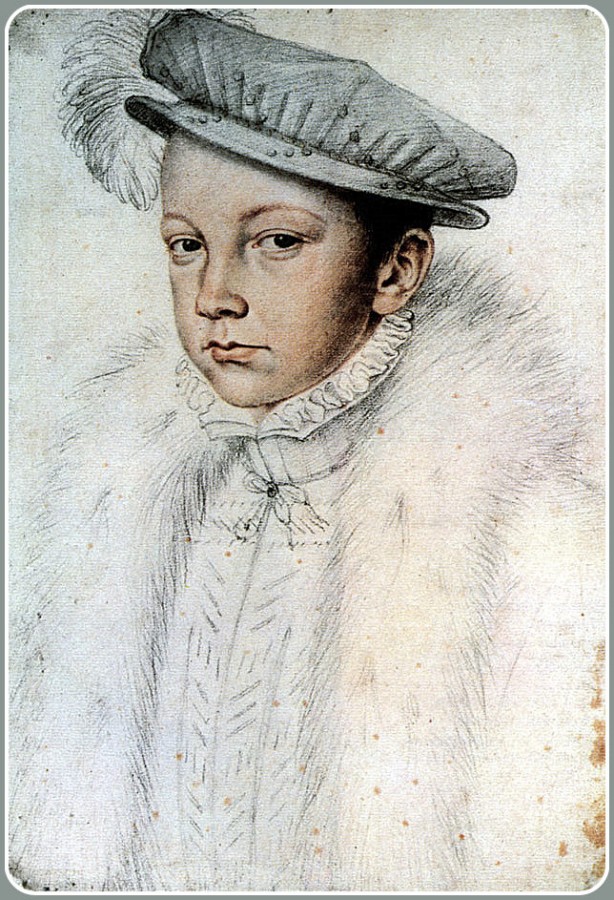
7. Francis II(January 19, 1544, Fontainebleau Palace, France - December 5, 1560, Orleans, France) - King of France from July 10, 1559, King Consort of Scotland from April 24, 1558. From the Valois dynasty. Son of Henry II and Catherine de Medici.
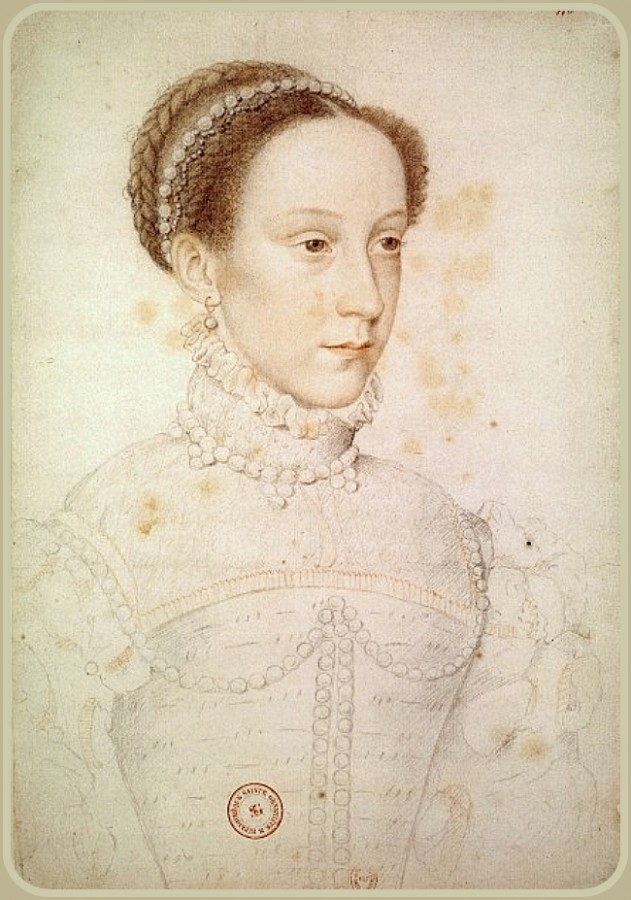
8. Maria I(née Mary Stewart, 8 December 1542 - 8 February 1587) - Queen of Scots from infancy, effectively reigning from 1561 until her deposition in 1567, as well as Queen of France in 1559-1560 (as the wife of King Francis II) and pretender to the English throne. The eldest son of Henry II, named after his grandfather, Francis I. On April 24, 1558, he married the young Queen of Scotland, Mary Stuart (he was the first of her three husbands). The agreement on this marriage was concluded on January 27, 1548 (when the bride and groom were 4 and 6 years old, respectively), and for the next 10 years, Maria was raised at the French court. Francis I loved his wife to the point of adoration.
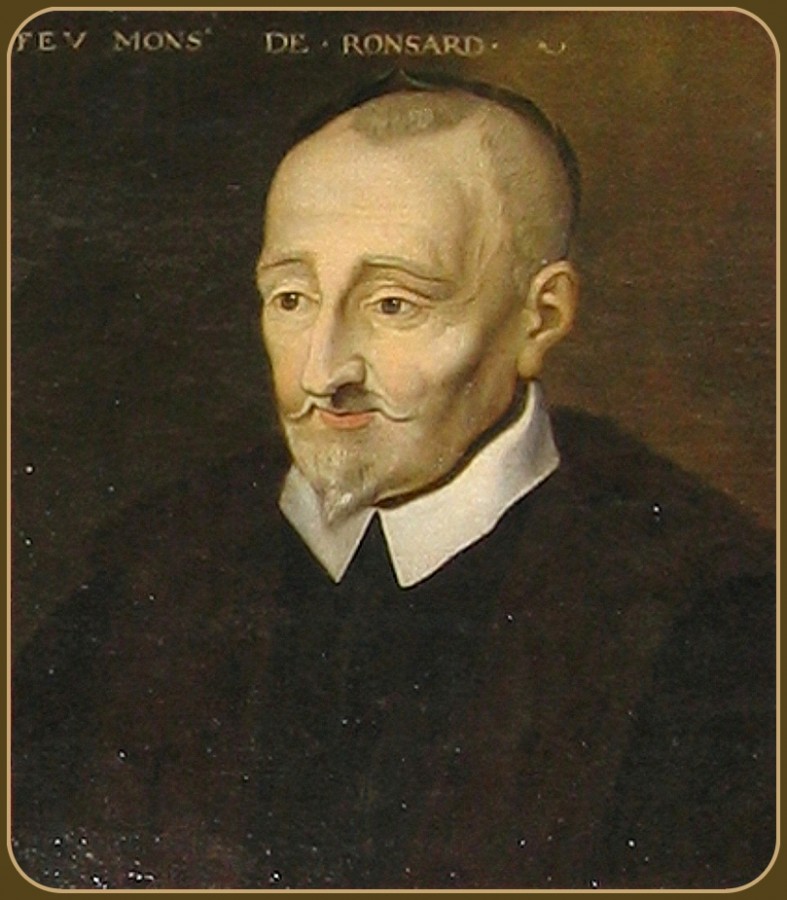
9. Pierre de Ronsard(between September 1 and September 11, 1524, La Possoniere castle, Vendomois - December 27, 1585, Saint-Côme Abbey, near Tours) - famous French poet XVI century. He headed the Pleiades association, which preached the enrichment of national poetry by the study of Greek and Roman literature.
He served as a page to Francis I, then at the Scottish court.
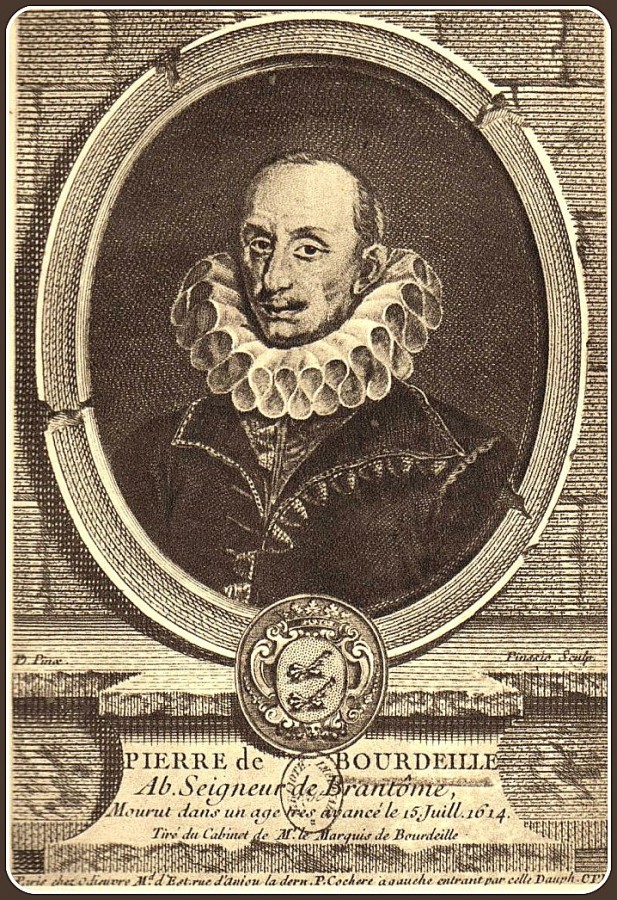
10. Pierre de Bourdeil, lord of Brantôme(c. 1540 - July 15, 1614) - chronicler of court life during the times of Catherine de Medici, one of the most widely read French authors Renaissance. Brantome's memoirs are written vividly and are full of anecdotes. His frankness regarding privacy court celebrities later, in Victorian era, seemed scandalous. The author's reluctance to evaluate even the most dissolute, by the standards of later times, behavior of his heroes allowed him to be accused not only of frivolity, but also of cynicism.
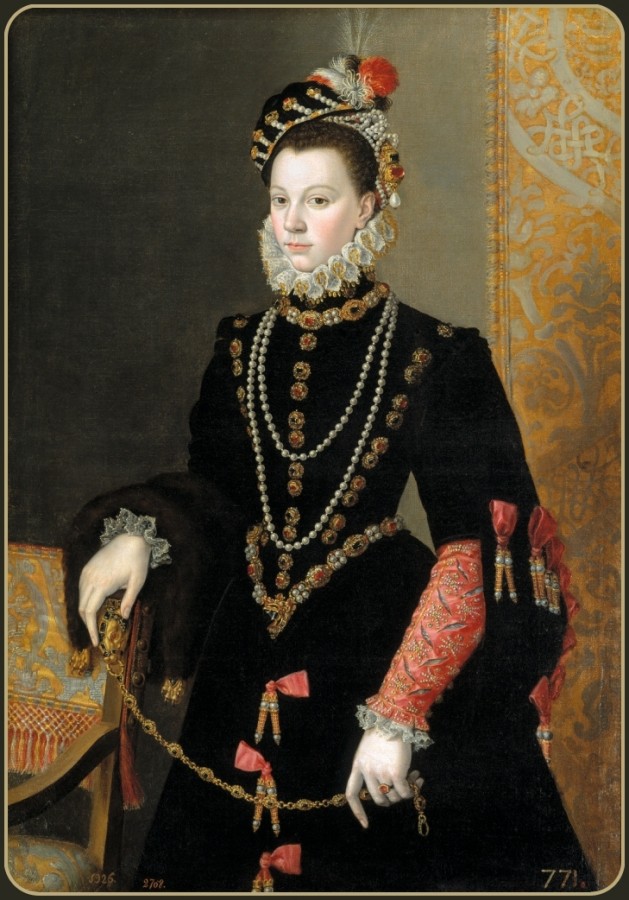
11. Elizabeth of Valois(April 2, 1545, Fontainebleau - October 3, 1568, Aranjuez) - French princess and queen of Spain, third wife of King Philip II of Spain.
Elizabeth of Valois was eldest daughter King of France Henry II of the Valois dynasty and his wife Catherine de Medici. Although she was engaged to the Spanish Infante Don Carlos, fate decreed otherwise, and at the end of the many years of war between France and Spain, which ended in 1559 with the signing of the peace treaty of Cateau Cambresis, she married the Spanish King Philip II, which was one of the terms of this agreement. Elisabeth Valois for a short time transformed from a French princess into a Spanish queen, whose intelligence, gentleness and beauty were highly valued throughout Europe. Elizabeth carried out the duties associated with her royal office in an exemplary manner.
Elizabeth inherited black hair, dark eyes and high intelligence from her Italian mother. But unlike her mother, Elizabeth had a softer character and more tact in her behavior; she was also distinguished by great piety. Catherine was surprised to discover in her daughter those qualities that she lacked, and over time they established a close, trusting relationship, which, after Elizabeth married Philip II, continued in the form of lively correspondence
Elizabeth died in 1568 due to another unsuccessful birth.
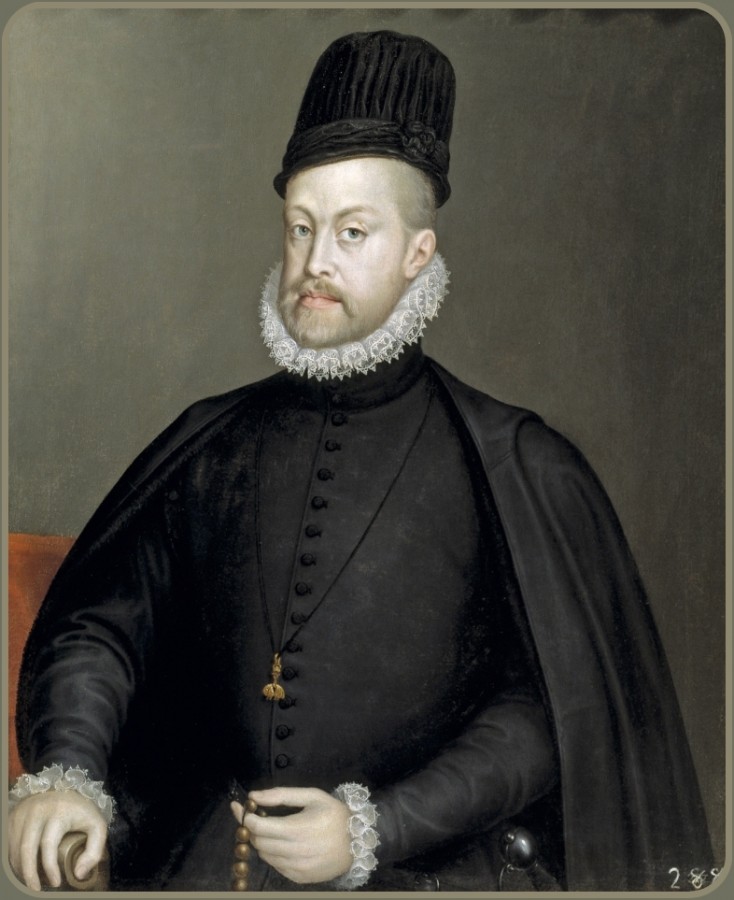
12. Philip II May 21, 1527 - September 13, 1598) - King of Spain from the Habsburg dynasty. The son and heir of the Holy Roman Emperor Charles V (aka Charles (Carlos) I, King of Castile and Aragon), Philip was King of Naples and Sicily from 1554, and from 1556, after his father’s abdication of the throne, became King of Spain and the Netherlands and the owner of all overseas possessions of Spain. In 1580 he also annexed Portugal and became its king. Husband of Elizabeth Valois.
When his mother died, Philip was not even twelve. In the serene environment of his childhood, he developed a deep love for nature. Subsequently, throughout his life, trips to nature, fishing and hunting became a desirable and best release for him after heavy workloads. From childhood, Philip was distinguished by deep religiosity. He also loved music and attached great importance so that you can include your children in it. Philip's letters, now over fifty, from Lisbon, where he had to spend two years without his young children, show him loving father: He worries about the health of the kids, is interested in his son’s first tooth and is worried about him getting a picture book to color. Perhaps this was due to the warmth that he received in abundance in his childhood years.
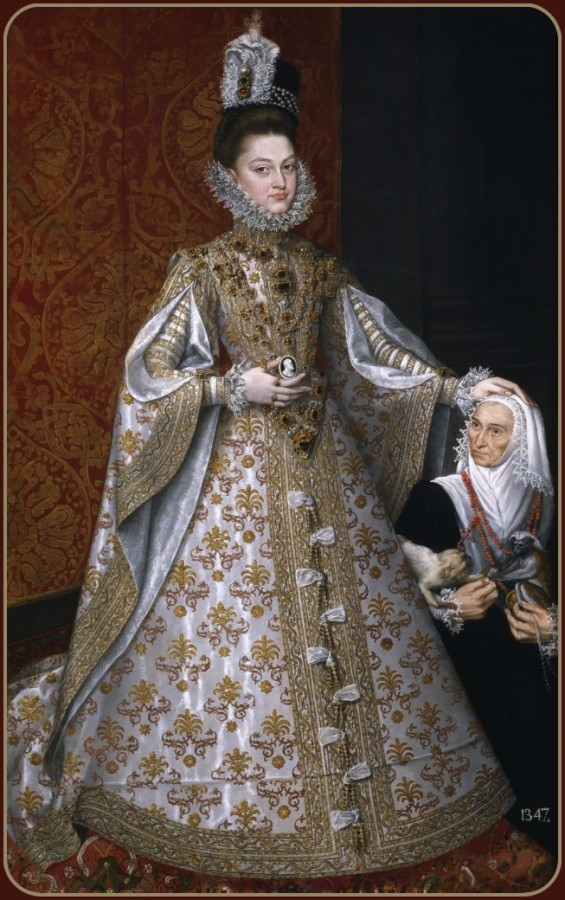
13. Isabella Clara Eugenia, Isabel Clara Eugenia (August 12, 1566, Segovia - December 1, 1633, Brussels) - Spanish infanta, ruler of the Spanish Netherlands. The parents of Infanta Isabel Clara Eugenia were King Philip II of Spain and Elizabeth of Valois.
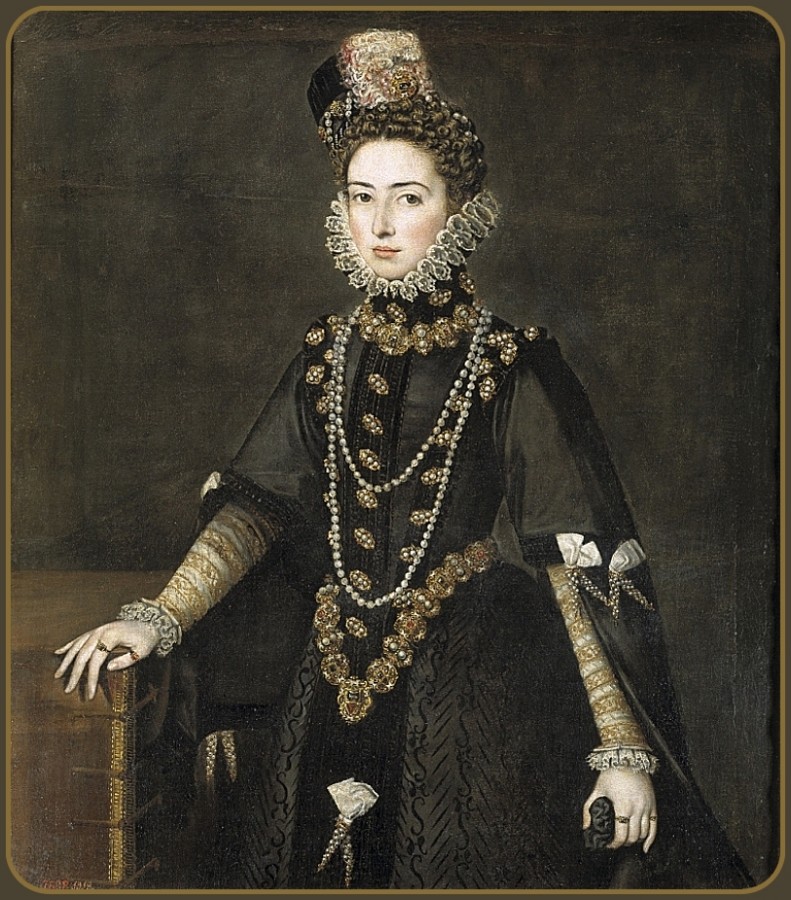
14. Catalina Michaela of Austria(and October 10, 1567, Madrid - November 6, 1597, Turin) - Spanish infanta and Duchess of Savoy, wife of Charles Emmanuel I of Savoy. Catalina Micaela was the youngest daughter of King Philip II of Spain and his third wife Elizabeth of Valois. She was named after her maternal grandmother Catherine de Medici and St. Michaela. Catalina Michaela married Duke Charles Emmanuel I of Savoy on March 18, 1585 in Zaragoza and left the Spanish court. Despite the separation, she maintained a lively correspondence with her father and other family members until his death. Catalina gave birth to 10 children and was most family life on demolitions. She died at the age of 29 on October 6, 1597 in Turin from complications caused by premature birth a year after the birth of her last child, Thomas Franz of Savoy. Thomas Franz was the grandfather of Eugene Franz of Savoy, better known as Prince Eugene of Savoy. Although Catalina suffered the same fate as her mother, she nonetheless fulfilled her dynastic duty and gave birth to an heir to the throne for the House of Savoy.
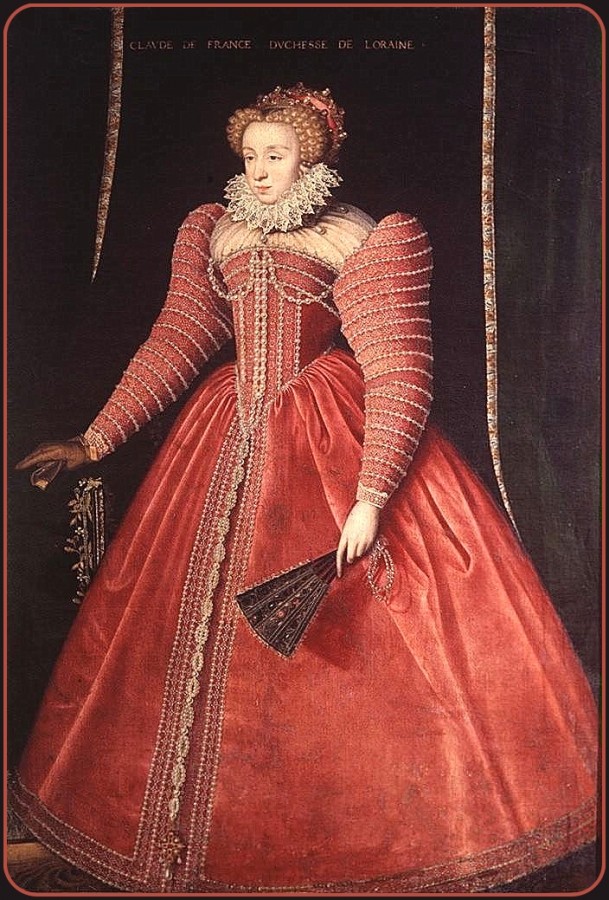
15. Claude Valois, or Claude of France(November 12, 1547, Fontainebleau - February 21, 1575, Nancy) - the second daughter of Henry II and Catherine de Medici. This modest, lame, hunchbacked princess was the beloved daughter of Catherine de Medici. Having married at the age of 11, at the age of 27 Claude died in childbirth. She had nine children.
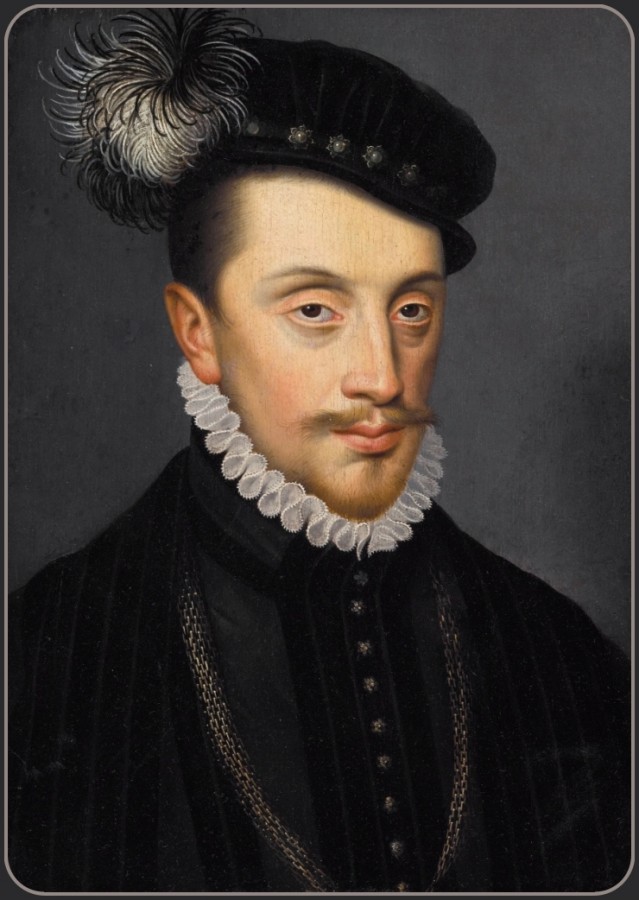
16. Charles III(February 18, 1543, Nancy - May 14, 1608, ibid.) - Duke of Lorraine from 1545 until his death. As a descendant of Gerhard I, he was supposed to be Charles II, but Lorraine historians, wanting to attribute Carolingian kinship to the Dukes of Lorraine, included Charles I of the Carolingian dynasty in the numbering. Eldest son of Duke of Lorraine François I and Christina of Denmark. Spouse Claude Valois.
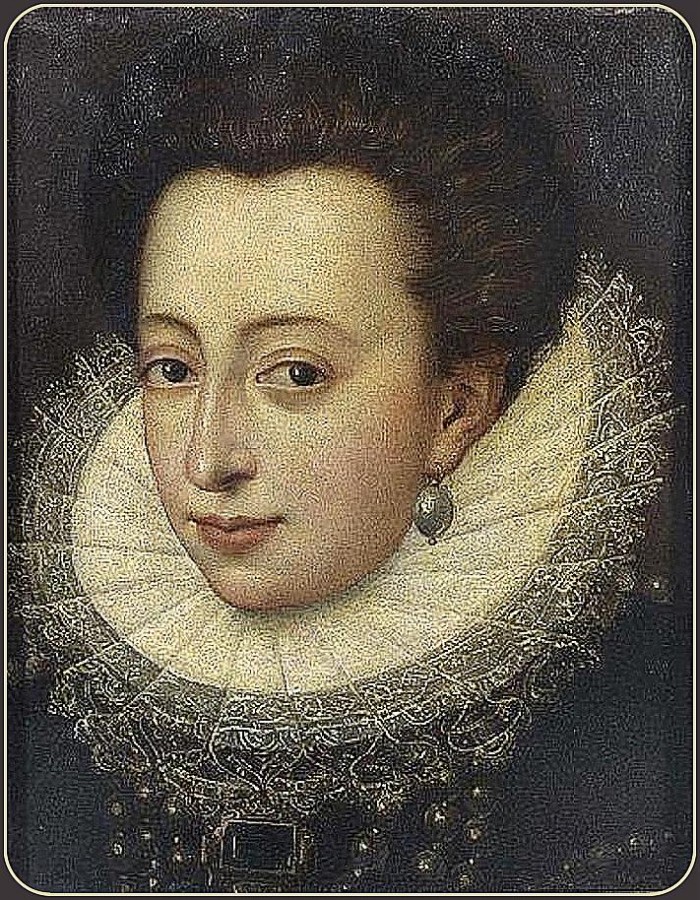
17. Christina of Lorraine(16 August 1565 - 19 December 1637) - Grand Duchess of Tuscany. Favorite granddaughter of Catherine de' Medici. Her parents were Duke Charles III and his wife Claude Valois, daughter of Catherine de' Medici. She received her name in honor of her paternal grandmother, Christina of Denmark. After her mother's death in 1575, Christina lived at the court of her grandmother Catherine de' Medici in Paris. In 1587, Francesco I (Grand Duke of Tuscany) died without a male heir, and his brother Ferdinand immediately proclaimed himself the new Duke. In search of a marriage option that would help him maintain political independence, Ferdinand settled on distant relative- Christina. Catherine de' Medici facilitated this marriage. Ferdinand and Christina had nine children.
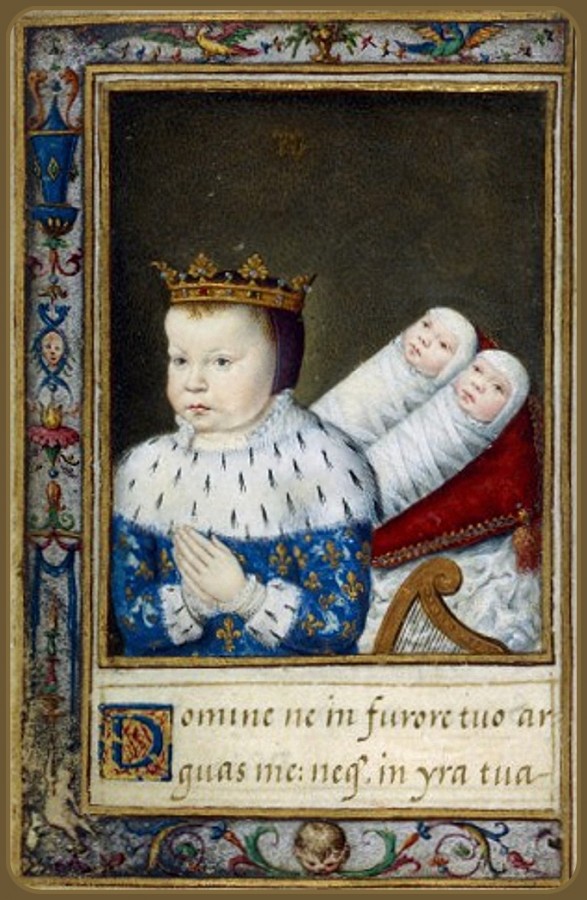
18. Louis III of Orleans(February 3, 1549, Fontainebleau, France - October 24, 1550, Mantes-la-Jolie, France) - Duke of Orleans, second son and fourth child in the family of Henry II, King of France and Catherine de' Medici. Brother of three kings of France - Francis II, Charles IX and Henry III. Like his older brother, he was given to be raised by Diane de Poitiers. According to some reports, they wanted to make him the heir of the Duke of Urbino, but the plans were not implemented. After baptism, he died in the city of Mantes-la-Jolie on October 24, 1550.
In the background of the painting are the last children of Catherine de Medici - twins Victoria(lived for 1 month and Zhanna(born dead). The birth was very difficult and doctors forbade Catherine to have children. This was in 1556.

19. Charles IX, Charles Maximilien(June 27, 1550 - May 30, 1574) - before the last king France from the Valois dynasty, from December 5, 1560. Third son of King Henry II and Catherine de Medici. His mother was his regent until August 17, 1563. Charles's reign was marked by numerous Wars of Religion and St. Bartholomew's Night - the notorious mass extermination of the Huguenots. At the age of 20 (November 26, 1570), he married Elizabeth of Austria. The king was interested in literature. Poems from his pen are known, as well as “Treatise on the Royal Hunt,” first published in 1625.
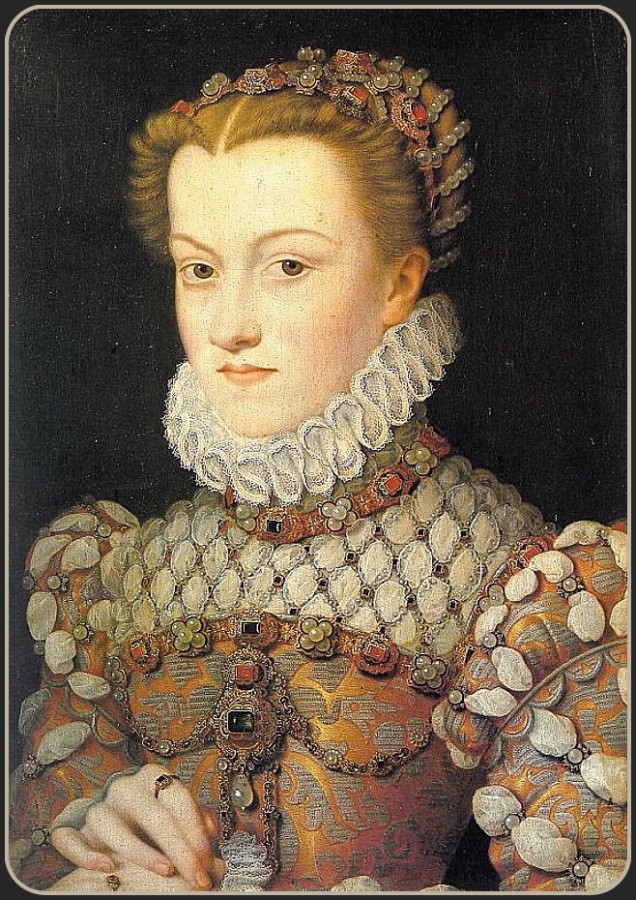
20. Elizabeth of Austria(July 5, 1554, Vienna - January 22, 1592, Vienna) - Queen of France, wife of King Charles IX of France. Elizabeth was the fifth child and second daughter of Emperor Maximilian II and his cousin, the Spanish Infanta Maria, daughter of Charles V and sister of King Philip II of Spain . On November 26, 1570, she married King Charles IX of France, who died in 1574. They had one daughter who lived only 5 years. She was considered one of the most beautiful princesses in Europe, with red-golden hair, a lovely face and a charming smile. But she was not just beautiful: the chronicler and poet Brantôme described Elizabeth this way: she was “one of the best, meekest, smartest and most virtuous queens who ever reigned from time immemorial.” Contemporaries agree on her intelligence, shyness, virtue, sympathetic heart and, above all, sincere piety. Widowed at the age of twenty, Elizabeth returned to Austria. In 1576, she retired to the monastery of the Clarissas, which she herself founded.
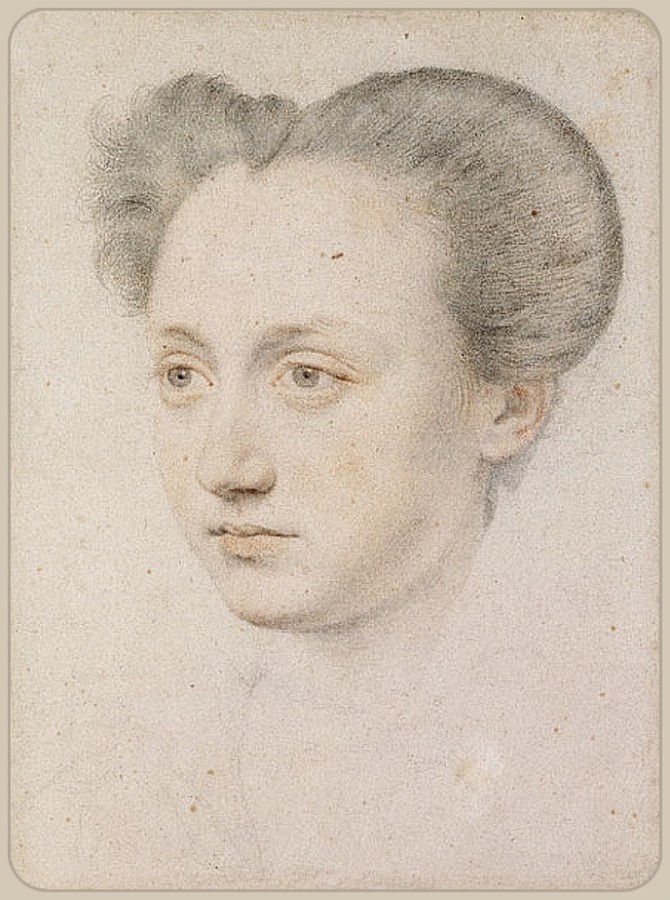
21. Maria Touchet(1549, Orleans - March 28, 1638, Paris) - official favorite of King Charles IX, mother of Catherine Henriette d'Entragues (favourite of the French king Henry IV after the death of Gabrielle d'Estrées in 1599, and mother of his two illegitimate children), and Charles de Valois (April 28, 1573 - September 24, 1650) - Count of Auvergne (1589-1650), Duke of Angoulême (1619-1650), Count de Ponthieu (1619-1650), Peer of France - illegitimate son Charles IX. Daughter of Lieutenant Jean Touchet, who served as assistant to the governor at the Orleans Court and his wife Marie Mathy. In the fall of 1566, at a ball (according to other sources, at a hunt) in Orleans, she met the future king of France, Charles IX, and fell in love with him at first sight. Maria was distinguished by her beauty, education, and meekness; According to her memoirs, a contemporary was “ round face, a beautiful cut, lively eyes, a well-proportioned nose, a small mouth, a delightfully defined lower part of the face.” Karl was fascinated by the young Flemish woman and took her to Paris. Here Maria was first a maid younger sister King Princess Margaret, then worked at the Louvre, and after St. Bartholomew's Night, as a result of which she was almost killed, she lived in Fayet Castle. Despite her status as the official favorite, Marie Touchet cheated on Karl.

22. Henry III of Valois(September 19, 1551, Fontainebleau - August 2, 1589, Saint-Cloud) - fourth son of Henry II, King of France and Catherine de Medici, Duke of Angoulême (1551-1574), Duke of Orleans (1560-1574), Duke of Anjou (1566-1574) , Duke of Bourbon (1566-1574), Duke of Auvergne (1569-1574), King of Poland and Grand Duke Lithuanian from February 21, 1573 to June 18, 1574 (formally until May 12, 1575), from May 30, 1574 the last king of France from the Valois dynasty.
Alexander-Eduard-Henry was a cheerful, friendly and smart child. The education of the young prince was carried out famous people of his time - François Carnavalet and Bishop Jacques Amiot, famous for his translations of Aristotle. In his youth, he read a lot, willingly held conversations about literature, took rhetoric lessons, danced and fenced well, and knew how to charm with his charm and elegance. Fluent in Italian (which he often spoke with his mother), he read the works of Machiavelli. Like all nobles, he early began to engage in various physical exercise and later, during military campaigns, he showed good skill in military affairs. Henry’s personality and behavior sharply distinguished him in the French court. And later, upon arrival in Poland, they called culture shock from the local population. In 1573, the Venetian ambassador to Paris, Morisoni, wrote about the prince’s luxurious clothes, his almost “ladylike delicacy,” and his earrings in each ear. Catherine herself, who loved Henry more than her other children, dreamed of leaving him the royal crown. She called him “my everything” and “my little eagle”, signed her letters to him “your dearly loving mother” and saw in him character traits that reminded her of her ancestors, the Medici. Heinrich was her favorite as a child, and later became her confidant.

23. Maria of Cleves, Countess de Beaufort (1553 - October 30, 1574, Paris) - the first wife of the second Prince of Condé. Someone else's bride, with whom Henry III fell in love and with whom he dreamed of marrying. The 21-year-old is “a child from the provinces with a pure heart, fresh cheeks, a slender figure, a healthy body and a heartfelt smile.” Catherine was horrified by her son's desire; Maria did not belong to the highest nobility at all. Through her efforts, her son’s plans were upset - Maria married someone else. Having ascended the throne, Henry III hoped to dissolve Mary's marriage and marry her. However, Maria soon died from postpartum complications. Since the king’s affection for Mary was no secret to anyone, no one wanted to take the liberty of informing him of the princess’s death. A note with a message was placed in a bundle of the king's daily correspondence. After reading it, Heinrich fainted, and it took a quarter of an hour to revive him. After a week of hysterics, the king fell into melancholy, dressed in mourning, retired to the chapel several times a day and often made pilgrimages.

24. Louise of Lorraine-Vaudemont(April 30, 1553 - January 29, 1601) - representative of the House of Lorraine, wife of Henry III of Valois and French queen from 1575 to 1589. Catherine de Medici was very surprised when Henry announced that he intended to marry Louise de Vaudemont. Henry III, unwilling to lose independence and fearing to become the husband of an overly domineering woman, he wanted to marry a tender and meek girl who would be his devoted assistant. He was too tired of the power of his own mother and did not want to find her in a wife. A confidant, Philippe Cheverny, writes in his “Memoirs”: From the words of the king, I understood that he wanted to choose a woman of his nationality, beautiful and pleasant. He needs her to love her and have children. He is not going to go to others, as his predecessors did. His heart was almost already inclined to Louise de Vaudemont. Having revealed his feelings, the king honored me and asked me to speak with the queen and achieve her positive answer.
Louise did not even imagine the possibility of such a marriage. The King of France left a deep imprint on her heart when she saw him as the Duke of Anjou. But she understood that she could not count on such a brilliant match. And when her stepmother entered her bedroom in the morning, she was very surprised, but, as Antoine Malet reports: ... her surprise increased even more when her stepmother curtsied three times in front of her before turning and greeting her as the Queen of France; the girl thought it was a joke and apologized for being in bed so late, but then the father entered the room and, sitting down by his daughter’s bed, said that the king of France wanted to take her as his wife... After the tragedy that happened on 1 August 1589, when Henry III was assassinated, Queen Louise would never again lift her mourning, becoming the "White Queen". According to royal etiquette, only white clothes are to be worn during mourning...

25. Hercule Francois (Francis) de Valois(March 18, 1555 - June 10, 1584), Duke of Alençon, then Duke of Anjou, was a French prince, the youngest son of King Henry II of France and Catherine de Medici, the only one of four brothers who never became king.
A charming child, he unfortunately suffered from smallpox at the age of 8, which left scars on his face. His pockmarked face and slightly crooked spine did not really correspond to the name given at birth - Hercule, that is, “Hercules”. At his confirmation, he changed his name to François in honor of his brother Francis II, King of France.
Before the accession to the throne of his brother, the Duke of Anjou (Henry III), he bore the title of Duke of Alençon, and then was called the Duke of Anjou. He stood at the head of political groups hostile to the French kings. Thus, he participated in a conspiracy against Charles IX, but was forgiven because he betrayed his comrades Count J.B. de La Mole and Count Annibal de Coconas, who were executed in 1574. He helped the Protestants, then took part in the war against them, opposed Philip II at the head of the rebellious Flemings, was proclaimed Duke of Brabant and Count of Flanders, but was soon expelled by the Flemings themselves. He died on June 10, 1584 from tuberculosis.
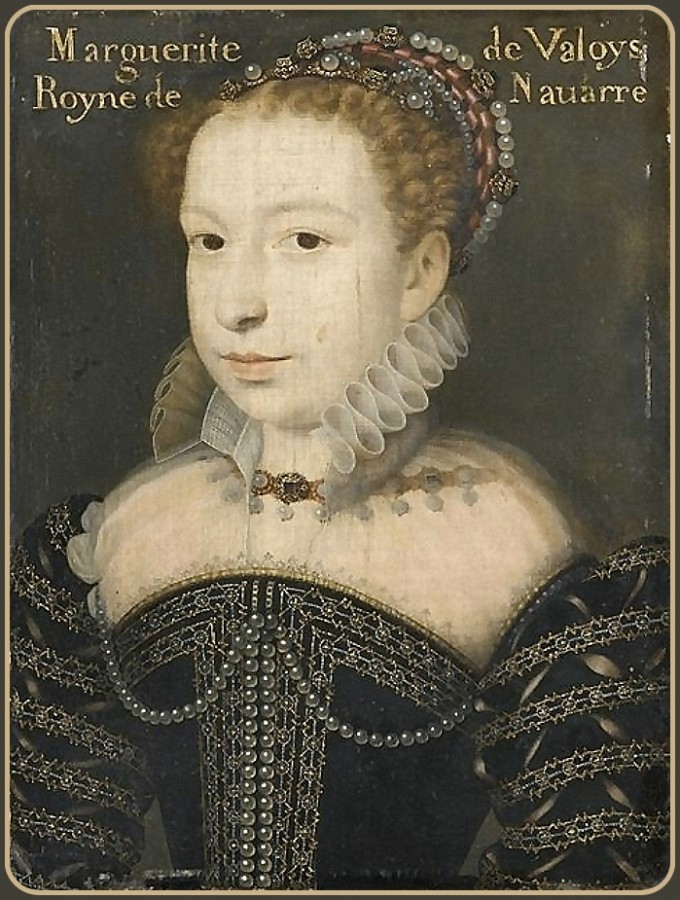
26. Marguerite de Valois(May 14, 1553, Saint-Germain Palace, Saint-Germain-en-Laye, France - March 27, 1615, Paris, France), also known as "Queen Margot" was a French princess, daughter of King Henry II and Catherine de' Medici. In 1572-1599, she was the wife of Henry de Bourbon, King of Navarre, who, under the name of Henry IV, took the French throne. From an early age, the girl was distinguished by her charm, independent disposition and sharp mind, and in the spirit of the Renaissance received a good education: knew Latin, ancient Greek, Italian, Spanish, studied philosophy and literature, and she herself had a good command of the pen. Nobody except her brother, King Charles, called her Margot.
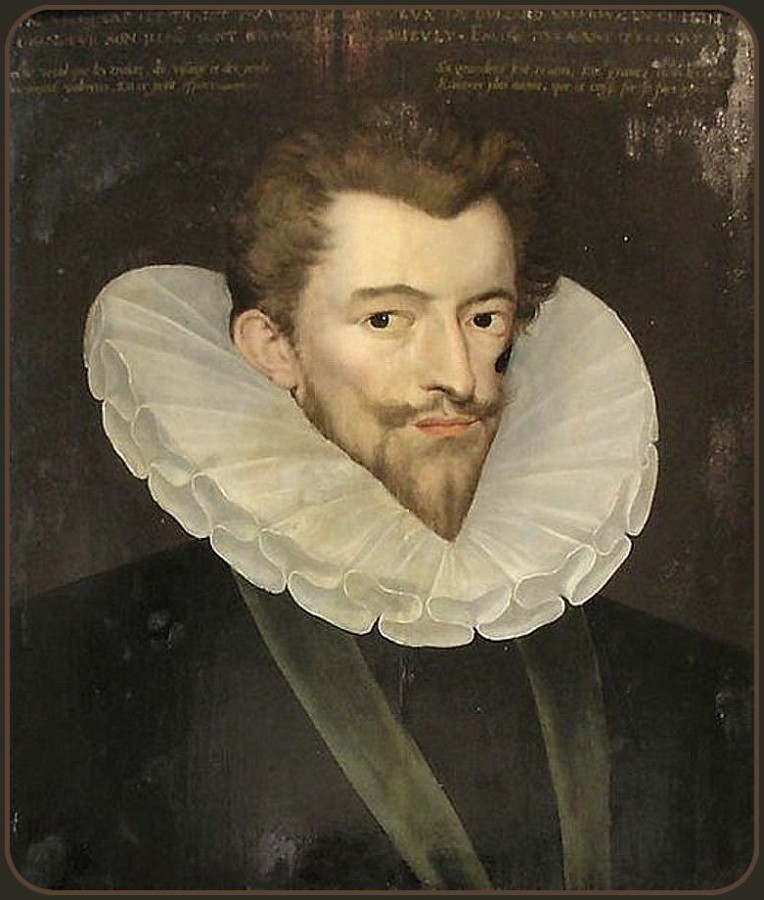
27. Henry (Henri) I of Lorraine, nicknamed Marked or Chopped (December 31, 1550 - December 23, 1588, Castle of Blois), 3rd Duke of Guise (1563 - 1588), Prince de Joinville, Peer of France (1563 - 1588), Knight of the Order of the Holy Spirit (1579) . French military and statesman during the Wars of Religion in France. Head of the Catholic League. The eldest son of Francois of Lorraine, Duke of Guise. Guise was one of the instigators of St. Bartholomew's Night and, in order to avenge the death of his father, took upon himself the murder of Admiral Coligny. In the skirmish of Dormans in 1575 he received a wound, as a result of which he was given the nickname Chopped. He had whirlwind romance with Margarita, but for political reasons their marriage was impossible. Apparently, Guise and Margarita retained feelings for each other until the end of their lives, which is confirmed by the queen’s secret correspondence.
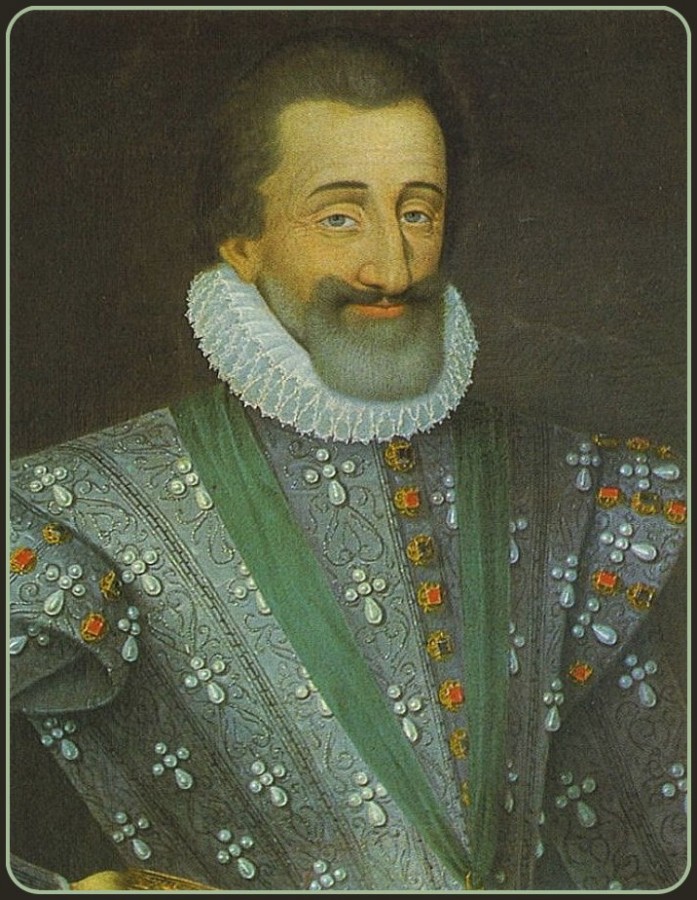
28. Henry (Henri) IV the Great(Henry of Navarre, Henry of Bourbon, December 13, 1553, Pau, Bearn - killed May 14, 1610, Paris) - leader of the Huguenots at the end of the Wars of Religion in France, king of Navarre from 1572 (as Henry III), king of France from 1589 (formally - from 1594), founder of the French royal dynasty Bourbons. First marriage - Margarita de Valois (no children), second marriage - Maria Medici (5 children).
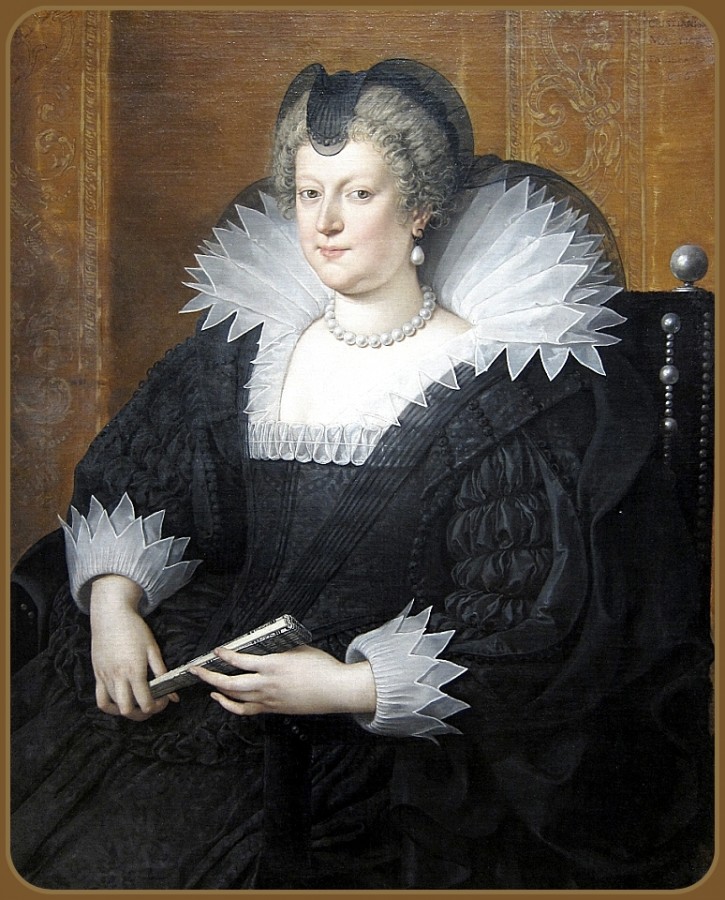
29. Maria de Medici(April 26, 1575, Florence - July 3, 1642, Cologne) - Queen of France, second wife of Henry IV of Bourbon, mother of Louis XIII.
So - the circle is closed.
From the first French queen from the Medici family, whose children were the last kings of France from the Valois dynasty, we come to the second French queen from the same Medici family, whose children belonged to the next, brilliant dynasty of kings of France - the Bourbon dynasty.
Catherine's parents - Lorenzo II, di Piero, de' Medici, Duke of Urbino (September 12, 1492 - May 4, 1519) and Madeleine de la Tour, Countess of Auvergne (c. 1500 - April 28, 1519) were married as a sign of the alliance between King Francis I of France and by Pope Leo X, Lorenzo's uncle, against Emperor Maximilian I of Habsburg. The young couple was very happy about the birth of their daughter; according to the chronicler, they “were as pleased as if it were a son.” But, unfortunately, their joy was not destined to last long: Catherine’s parents died in the first month of her life - her mother on the 15th day after giving birth (at the age of nineteen), and her father outlived his wife by only six days, leaving the newborn as an inheritance Duchy of Urbino and County of Auvergne. After this, the newborn was cared for by her grandmother Alfonsina Orsini until her death in 1520. Catherine was raised by her aunt, Clarissa Strozzi, along with her children, whom Catherine loved as siblings all her life. One of them, Pietro Strozzi, rose to the rank of marshal's baton in the French service. The death of Pope Leo X in 1521 led to a break in Medici power on the Holy See until Cardinal Giulio de' Medici became Clement VII in 1523. In 1527, the Medici in Florence were overthrown, and Catherine became a hostage - she was imprisoned in a monastery. Clement was forced to recognize and crown Charles of Habsburg as Holy Roman Emperor in exchange for his help in recapturing Florence and freeing the young duchess. 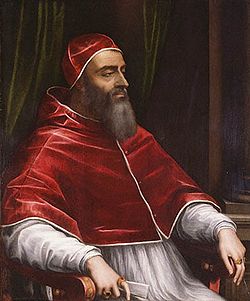 Pope Clement VII In October 1529, the troops of Charles V besieged Florence. During the siege, there were calls and threats to kill Catherine. There were other ideas regarding the fate of Catherine: they proposed placing the girl on the wall between two battlements under artillery fire, or giving her to the soldiers to be mocked. Although the city resisted the siege, on August 12, 1530, famine and plague forced Florence to surrender. Clement met Catherine in Rome with tears in his eyes. It was then that he began to search for a groom for her, considering many options, but when in 1531 the French king Francis I proposed the candidacy of his second son Henry, Clement immediately jumped at the chance: the young Duke of Orleans was the most profitable match for his niece Catherine . Fourteen-year-old Catherine, leaving Florence on September 1, 1533, said goodbye to Italy forever. Catherine could not be called beautiful. On her arrival in Rome, one Venetian ambassador described her as "red-haired, short and thin, but with expressive eyes" - typical appearance Medici family. But Catherine was able to impress the refined French court, spoiled by luxury, by turning to the help of one of the most famous Florentine craftsmen, who made shoes for the young bride. high heels. Her appearance at the French court caused a sensation. The wedding, which took place in Marseilles on October 28, 1533, was a major event marked by extravagance and the distribution of gifts. Europe has not seen such a gathering of the highest clergy for a long time. Pope Clement VII himself attended the ceremony, accompanied by many cardinals. “The wedding of Henry Valois and Catherine lasted thirty-four days,” Honore de Balzac said about the events of distant times. “...The Pope demanded that both of these teenagers become actually husband and wife on the very day of the celebration - he was so afraid of the various tricks and tricks that were in use at that time.” He wanted to make sure that the union was now indissoluble and Francis I could not refer to “non-consummation of marriage” in order to return Catherine to him. However, the king himself announced his decision to be present at the wedding night of the young newlyweds - this fact is confirmed by several testimonies. After the wedding, 34 days of continuous feasts and balls followed. On wedding feast Italian chefs first introduced the French court to a new dessert made from fruit and ice - this was the first ice cream.
Pope Clement VII In October 1529, the troops of Charles V besieged Florence. During the siege, there were calls and threats to kill Catherine. There were other ideas regarding the fate of Catherine: they proposed placing the girl on the wall between two battlements under artillery fire, or giving her to the soldiers to be mocked. Although the city resisted the siege, on August 12, 1530, famine and plague forced Florence to surrender. Clement met Catherine in Rome with tears in his eyes. It was then that he began to search for a groom for her, considering many options, but when in 1531 the French king Francis I proposed the candidacy of his second son Henry, Clement immediately jumped at the chance: the young Duke of Orleans was the most profitable match for his niece Catherine . Fourteen-year-old Catherine, leaving Florence on September 1, 1533, said goodbye to Italy forever. Catherine could not be called beautiful. On her arrival in Rome, one Venetian ambassador described her as "red-haired, short and thin, but with expressive eyes" - typical appearance Medici family. But Catherine was able to impress the refined French court, spoiled by luxury, by turning to the help of one of the most famous Florentine craftsmen, who made shoes for the young bride. high heels. Her appearance at the French court caused a sensation. The wedding, which took place in Marseilles on October 28, 1533, was a major event marked by extravagance and the distribution of gifts. Europe has not seen such a gathering of the highest clergy for a long time. Pope Clement VII himself attended the ceremony, accompanied by many cardinals. “The wedding of Henry Valois and Catherine lasted thirty-four days,” Honore de Balzac said about the events of distant times. “...The Pope demanded that both of these teenagers become actually husband and wife on the very day of the celebration - he was so afraid of the various tricks and tricks that were in use at that time.” He wanted to make sure that the union was now indissoluble and Francis I could not refer to “non-consummation of marriage” in order to return Catherine to him. However, the king himself announced his decision to be present at the wedding night of the young newlyweds - this fact is confirmed by several testimonies. After the wedding, 34 days of continuous feasts and balls followed. On wedding feast Italian chefs first introduced the French court to a new dessert made from fruit and ice - this was the first ice cream. ![]() On September 25, 1534, Clement VII died unexpectedly. Paul III, who replaced him, dissolved the alliance with France and refused to pay Catherine's dowry. Catherine's political value suddenly disappeared, thereby worsening her position in an unfamiliar country. King Francis complained that “the girl came to me completely naked.” Catherine, born in merchant Florence, where her parents were not concerned with giving their offspring a comprehensive education, had a very difficult time at the sophisticated French court. She felt like an ignorant person who did not know how to elegantly construct phrases and made many mistakes in her letters. We must not forget that French was not native to her, she spoke with an accent, and although she spoke quite clearly, the ladies of the court contemptuously pretended that they did not understand her well. Catherine was isolated from society and suffered from loneliness and hostility from the French, who arrogantly called her “Italian” and “merchant’s wife.” In 1536, the eighteen-year-old Dauphin Francis unexpectedly died and Catherine's husband became heir to the French throne. Now Catherine had to worry about the future of the throne. The death of his brother-in-law marked the beginning of speculation about the involvement of the Florentine woman in his poisoning for the quick accession of “Catherine the Poisoner” to the French throne: the heir, who drank a glass of ice water in Lyon after a game of ball, suddenly died. According to the official version, the Dauphin died of a cold, nevertheless the courtier, the Italian Count of Montecuccoli, served him, heated gambling, a bowl with cold water, was executed.
On September 25, 1534, Clement VII died unexpectedly. Paul III, who replaced him, dissolved the alliance with France and refused to pay Catherine's dowry. Catherine's political value suddenly disappeared, thereby worsening her position in an unfamiliar country. King Francis complained that “the girl came to me completely naked.” Catherine, born in merchant Florence, where her parents were not concerned with giving their offspring a comprehensive education, had a very difficult time at the sophisticated French court. She felt like an ignorant person who did not know how to elegantly construct phrases and made many mistakes in her letters. We must not forget that French was not native to her, she spoke with an accent, and although she spoke quite clearly, the ladies of the court contemptuously pretended that they did not understand her well. Catherine was isolated from society and suffered from loneliness and hostility from the French, who arrogantly called her “Italian” and “merchant’s wife.” In 1536, the eighteen-year-old Dauphin Francis unexpectedly died and Catherine's husband became heir to the French throne. Now Catherine had to worry about the future of the throne. The death of his brother-in-law marked the beginning of speculation about the involvement of the Florentine woman in his poisoning for the quick accession of “Catherine the Poisoner” to the French throne: the heir, who drank a glass of ice water in Lyon after a game of ball, suddenly died. According to the official version, the Dauphin died of a cold, nevertheless the courtier, the Italian Count of Montecuccoli, served him, heated gambling, a bowl with cold water, was executed. ![]() The birth of an illegitimate child to her husband in 1537 confirmed rumors about Catherine’s infertility. Many advised the king to annul the marriage. Under pressure from her husband, who wanted to consolidate her position with the birth of an heir, Catherine was treated for a long time and in vain by various magicians and healers with one single goal - to get pregnant. Every possible means was used to achieve successful conception, including drinking mule urine and wearing cow dung and deer antlers on the lower abdomen. Finally, on January 20, 1544, Catherine gave birth to a son. The boy was named Francis in honor of his grandfather, reigning king(he even shed tears of happiness when he learned about this). After her first pregnancy, Catherine seemed to no longer have problems conceiving. With the birth of several more heirs, Catherine strengthened her position at the French court. The long-term future of the Valois dynasty seemed assured. The sudden miraculous cure for infertility is associated with the famous doctor, alchemist, astrologer and fortuneteller Michel Nostradamus, one of the few members of Catherine’s close circle of confidants. Heinrich often played with children and was even present at their births. In 1556, during her next birth, surgeons saved Catherine from death by breaking off the legs of one of the twins, Jeanne, who lay dead in her mother’s womb for six hours. However, the second girl, Victoria, was destined to live only six weeks. In connection with this birth, which was very difficult and almost caused the death of Catherine, doctors advised the royal couple not to think about having new children anymore; after this advice, Henry stopped visiting his wife’s bedroom, spending everything free time with his favorite Diane de Poitiers
The birth of an illegitimate child to her husband in 1537 confirmed rumors about Catherine’s infertility. Many advised the king to annul the marriage. Under pressure from her husband, who wanted to consolidate her position with the birth of an heir, Catherine was treated for a long time and in vain by various magicians and healers with one single goal - to get pregnant. Every possible means was used to achieve successful conception, including drinking mule urine and wearing cow dung and deer antlers on the lower abdomen. Finally, on January 20, 1544, Catherine gave birth to a son. The boy was named Francis in honor of his grandfather, reigning king(he even shed tears of happiness when he learned about this). After her first pregnancy, Catherine seemed to no longer have problems conceiving. With the birth of several more heirs, Catherine strengthened her position at the French court. The long-term future of the Valois dynasty seemed assured. The sudden miraculous cure for infertility is associated with the famous doctor, alchemist, astrologer and fortuneteller Michel Nostradamus, one of the few members of Catherine’s close circle of confidants. Heinrich often played with children and was even present at their births. In 1556, during her next birth, surgeons saved Catherine from death by breaking off the legs of one of the twins, Jeanne, who lay dead in her mother’s womb for six hours. However, the second girl, Victoria, was destined to live only six weeks. In connection with this birth, which was very difficult and almost caused the death of Catherine, doctors advised the royal couple not to think about having new children anymore; after this advice, Henry stopped visiting his wife’s bedroom, spending everything free time with his favorite Diane de Poitiers  Diane de Poitiers Back in 1538, the thirty-nine-year-old beautiful widow Diana captivated the nineteen-year-old heir to the throne, Henry of Orleans, which over time allowed her to become an extremely influential person, as well as (in the opinion of many) the true ruler of the state. In 1547, Henry spent a third of every day with Diana. Having become king, he gave his beloved the castle of Chenonceau. When King Francis I died and Henry II ascended the throne, it was not Catherine de Medici, his wife, who became the real queen, but Diana. Even at the coronation she took an honorary public place, while Catherine was at a distant podium. This showed everyone that Diana had completely taken the place of Catherine, who, in turn, was forced to endure her husband’s beloved. She, like a real Medici, even managed to overcome herself, humble her pride, and win over her husband’s influential favorite. Diana was very pleased that Henry was married to a woman who preferred not to interfere and turned a blind eye to everything. Having become Diana's faithful knight, Henry wore the colors of the mistress of his heart: white and black - right up to the last breath and decorated his rings and clothes with the double monogram “DH” (Diana - Henry). On March 31, 1547, Francis I died and Henry II ascended the throne. Catherine became Queen of France. The coronation took place in the Basilica of Saint-Denis in June 1549. During the reign of her husband, Catherine had only minimal influence on the administration of the kingdom. Even in Henry's absence, her power was very limited. In early April 1559, Henry II signed the peace treaty of Cateau-Cambresis, ending the long wars between France, Italy and England. The agreement was strengthened by the engagement of Catherine and Henry's fourteen-year-old daughter, Princess Elizabeth, to thirty-two-year-old Philip II of Spain. Defying the predictions of the astrologer Luca Gorico and Nostradamus, who advised him to abstain from tournaments, Henry decided to participate in the competition. On June 30 or July 1, 1559, he fought in a duel with the lieutenant of his Scots guard, Earl Gabriel de Montgomery. Montgomery's split spear passed through the slot of the king's helmet. Through Henry's eye, the tree entered the brain, mortally wounding the monarch. The king was taken to the castle de Tournel, where the remaining fragments of the ill-fated spear were removed from his face. The best doctors in the kingdom fought for Henry's life. Catherine was at her husband's bedside all the time, and Diana did not appear, probably for fear of being sent away by the queen. From time to time, Henry even felt well enough to dictate letters and listen to music, but he soon became blind and lost his speech. Diana was removed during the agony of Henry II. She was forced to return the Crown Jewels in accordance with the inventory. The Duchess was frightened: she asked Catherine's forgiveness and handed her her property and her life. The Queen Mother was generous. She limited herself to forbidding Diana and one of her daughters, the Duchess de Bouillon, from coming to court; but not the other - to the Duchess d'Aumale - the daughter-in-law of the Duke of Guise. Perhaps, in order to preserve the inheritance of the Duke d'Aumale, the Guises did not confiscate her fortune from Diana, as she herself once did in relation to the Duchess d'Etampes. Catherine was content with which forced the former favorite to sell Chenonceau to her, giving her her possession of Chaumont in return. Everyone was surprised by the queen’s generosity: her jealousy and contempt for Diana during her husband’s life were well known; Catherine was afraid of the influence of Diana’s powerful family alliances. Therefore, she limited herself to the resignation of the duchess. her supporters: thus, the keeper of the seals, Cardinal Jean Bertrand, was forced to give up his place to Chancellor Olivier. Later, the queen would be able to express her contempt: going to the siege of Rouen in September 1562, she would pass by Anet and “would not see Madame de Valantinois or enter her house.”
Diane de Poitiers Back in 1538, the thirty-nine-year-old beautiful widow Diana captivated the nineteen-year-old heir to the throne, Henry of Orleans, which over time allowed her to become an extremely influential person, as well as (in the opinion of many) the true ruler of the state. In 1547, Henry spent a third of every day with Diana. Having become king, he gave his beloved the castle of Chenonceau. When King Francis I died and Henry II ascended the throne, it was not Catherine de Medici, his wife, who became the real queen, but Diana. Even at the coronation she took an honorary public place, while Catherine was at a distant podium. This showed everyone that Diana had completely taken the place of Catherine, who, in turn, was forced to endure her husband’s beloved. She, like a real Medici, even managed to overcome herself, humble her pride, and win over her husband’s influential favorite. Diana was very pleased that Henry was married to a woman who preferred not to interfere and turned a blind eye to everything. Having become Diana's faithful knight, Henry wore the colors of the mistress of his heart: white and black - right up to the last breath and decorated his rings and clothes with the double monogram “DH” (Diana - Henry). On March 31, 1547, Francis I died and Henry II ascended the throne. Catherine became Queen of France. The coronation took place in the Basilica of Saint-Denis in June 1549. During the reign of her husband, Catherine had only minimal influence on the administration of the kingdom. Even in Henry's absence, her power was very limited. In early April 1559, Henry II signed the peace treaty of Cateau-Cambresis, ending the long wars between France, Italy and England. The agreement was strengthened by the engagement of Catherine and Henry's fourteen-year-old daughter, Princess Elizabeth, to thirty-two-year-old Philip II of Spain. Defying the predictions of the astrologer Luca Gorico and Nostradamus, who advised him to abstain from tournaments, Henry decided to participate in the competition. On June 30 or July 1, 1559, he fought in a duel with the lieutenant of his Scots guard, Earl Gabriel de Montgomery. Montgomery's split spear passed through the slot of the king's helmet. Through Henry's eye, the tree entered the brain, mortally wounding the monarch. The king was taken to the castle de Tournel, where the remaining fragments of the ill-fated spear were removed from his face. The best doctors in the kingdom fought for Henry's life. Catherine was at her husband's bedside all the time, and Diana did not appear, probably for fear of being sent away by the queen. From time to time, Henry even felt well enough to dictate letters and listen to music, but he soon became blind and lost his speech. Diana was removed during the agony of Henry II. She was forced to return the Crown Jewels in accordance with the inventory. The Duchess was frightened: she asked Catherine's forgiveness and handed her her property and her life. The Queen Mother was generous. She limited herself to forbidding Diana and one of her daughters, the Duchess de Bouillon, from coming to court; but not the other - to the Duchess d'Aumale - the daughter-in-law of the Duke of Guise. Perhaps, in order to preserve the inheritance of the Duke d'Aumale, the Guises did not confiscate her fortune from Diana, as she herself once did in relation to the Duchess d'Etampes. Catherine was content with which forced the former favorite to sell Chenonceau to her, giving her her possession of Chaumont in return. Everyone was surprised by the queen’s generosity: her jealousy and contempt for Diana during her husband’s life were well known; Catherine was afraid of the influence of Diana’s powerful family alliances. Therefore, she limited herself to the resignation of the duchess. her supporters: thus, the keeper of the seals, Cardinal Jean Bertrand, was forced to give up his place to Chancellor Olivier. Later, the queen would be able to express her contempt: going to the siege of Rouen in September 1562, she would pass by Anet and “would not see Madame de Valantinois or enter her house.” 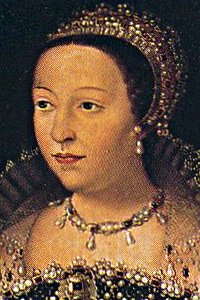 Henry II died on July 10, 1559. From that day on, Catherine chose as her emblem a broken spear with the inscription “Lacrymae hinc, hinc dolor” (“from this all my tears and my pain”) and until the end of her days she wore black clothes as a sign of mourning. She was the first to wear black mourning. Before this, in medieval France, mourning was white. Despite everything, Catherine adored her husband. “I loved him so much...” she wrote to her daughter Elizabeth after Henry’s death. Catherine de Medici mourned for her husband for thirty years and went down in French history under the name “The Black Queen.” Her eldest son, fifteen-year-old Francis II, became the King of France. Catherine took up state affairs, made political decisions, and exercised control over the Royal Council. However, Catherine never ruled the entire country, which was in chaos and on the brink of civil war. Many parts of France were virtually dominated by local nobles. Complex tasks, which Catherine found herself in front of, were confusing and to some extent difficult for her to understand. She called on religious leaders on both sides to engage in dialogue to resolve their doctrinal differences. Despite her optimism, the "Conference of Poissy" ended in failure on October 13, 1561, dissolving itself without the queen's permission. Catherine's point of view on religious issues was naive because she saw the religious schism from a political perspective. “She underestimated the power of religious conviction, imagining that all would be well if only she could persuade both parties to agree.” “The king’s health is very uncertain,” the Tuscan ambassador reported to his court, “and Nostradamus, in his predictions for this month, says that the king’s death will occur before the new year.” And so it happened: on December 5, 1560, Francis II died. The death was blamed on the cupbearer, who allegedly mixed poison into the intoxicating drink. However, historians are still arguing about the reliability of this fact. But it is definitely established that even when Francis was the Dauphin (in 1555), an attempt was made to poison him. The scenario is traditional: a luxurious feast, a cupbearer... And if not for the healing talent of Nostradamus, Francis would have died as the Dauphin.
Henry II died on July 10, 1559. From that day on, Catherine chose as her emblem a broken spear with the inscription “Lacrymae hinc, hinc dolor” (“from this all my tears and my pain”) and until the end of her days she wore black clothes as a sign of mourning. She was the first to wear black mourning. Before this, in medieval France, mourning was white. Despite everything, Catherine adored her husband. “I loved him so much...” she wrote to her daughter Elizabeth after Henry’s death. Catherine de Medici mourned for her husband for thirty years and went down in French history under the name “The Black Queen.” Her eldest son, fifteen-year-old Francis II, became the King of France. Catherine took up state affairs, made political decisions, and exercised control over the Royal Council. However, Catherine never ruled the entire country, which was in chaos and on the brink of civil war. Many parts of France were virtually dominated by local nobles. Complex tasks, which Catherine found herself in front of, were confusing and to some extent difficult for her to understand. She called on religious leaders on both sides to engage in dialogue to resolve their doctrinal differences. Despite her optimism, the "Conference of Poissy" ended in failure on October 13, 1561, dissolving itself without the queen's permission. Catherine's point of view on religious issues was naive because she saw the religious schism from a political perspective. “She underestimated the power of religious conviction, imagining that all would be well if only she could persuade both parties to agree.” “The king’s health is very uncertain,” the Tuscan ambassador reported to his court, “and Nostradamus, in his predictions for this month, says that the king’s death will occur before the new year.” And so it happened: on December 5, 1560, Francis II died. The death was blamed on the cupbearer, who allegedly mixed poison into the intoxicating drink. However, historians are still arguing about the reliability of this fact. But it is definitely established that even when Francis was the Dauphin (in 1555), an attempt was made to poison him. The scenario is traditional: a luxurious feast, a cupbearer... And if not for the healing talent of Nostradamus, Francis would have died as the Dauphin. 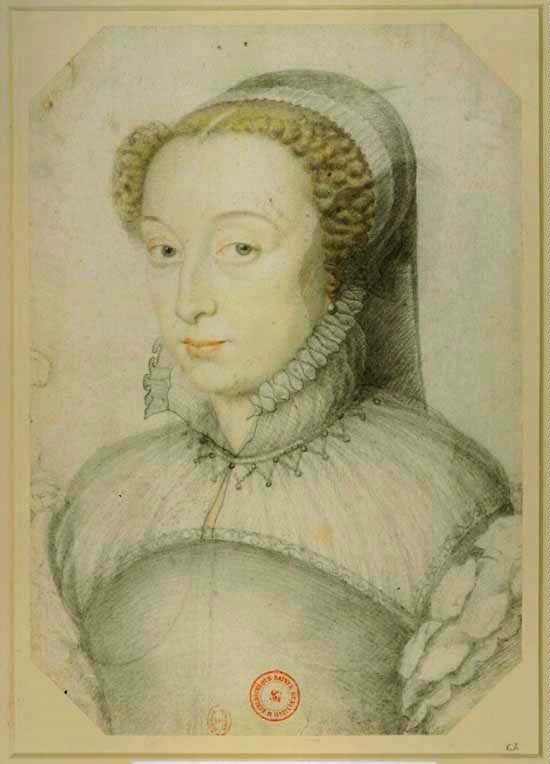 Catherine declared herself regent: the new king, Charles IX, was only ten years old. This sullen and cruel teenager had a morbid addiction to blood - he killed animals for his own pleasure, cut the throats of his dogs, and strangled birds. He was never able to govern the state on his own and showed minimal interest in state affairs. Karl was also prone to hysterics, which over time turned into outbursts of rage. He suffered from shortness of breath - a sign of tuberculosis, which ultimately brought him to the grave. Arrogant, contemptuous and sickly, Karl grew into an intolerable tyrant. His relationship with his mother left much to be desired, although he could not yet do without her advice. Repeated attempts to poison this monarch, some authors note, ended in nothing. Charles reigned for fourteen years (all this time Nostradamus was listed as the court physician) and died in 1574. Through dynastic marriages, Catherine sought to expand and strengthen the interests of the House of Valois. In 1570, Charles was married to the daughter of Emperor Maximilian II, Elizabeth. Catherine tried to marry one of her younger sons to Elizabeth of England. She did not forget about her youngest daughter Margaret, whom she saw as the bride of the again widowed Philip II of Spain. However, soon Catherine had plans to unite the Bourbons and Valois through the marriage of Margaret and Henry of Navarre. Margaret, however, encouraged the attention of Henry de Guise, son of the late Duke François de Guise. When Catherine and Karl found out about this, Margarita received a good thrashing. The escaped Henry of Guise hastily married Catherine of Cleves, which restored the favor of the French court towards him. Perhaps it was this incident that caused the split between Catherine and Giza. Between 1571 and 1573, Catherine persistently tried to win over the mother of Henry of Navarre, Queen Jeanne. When, in another letter, Catherine expressed a desire to see her children, while promising not to harm them, Jeanne d'Albret replied: “Forgive me if, reading this, I want to laugh, because you want to free me from a fear that I never had. I never thought that, as they say, you eat small children.” Ultimately, Joan agreed to a marriage between her son Henry and Margaret, with the condition that Henry would continue to adhere to the Huguenot faith. Shortly after arriving in Paris to prepare for the wedding, forty-four-year-old Jeanne fell ill and died. The Huguenots were quick to accuse Catherine of killing Jeanne with poisoned gloves. The wedding of Henry of Navarre and Margaret of Valois took place on August 18, 1572 at Notre Dame Cathedral.
Catherine declared herself regent: the new king, Charles IX, was only ten years old. This sullen and cruel teenager had a morbid addiction to blood - he killed animals for his own pleasure, cut the throats of his dogs, and strangled birds. He was never able to govern the state on his own and showed minimal interest in state affairs. Karl was also prone to hysterics, which over time turned into outbursts of rage. He suffered from shortness of breath - a sign of tuberculosis, which ultimately brought him to the grave. Arrogant, contemptuous and sickly, Karl grew into an intolerable tyrant. His relationship with his mother left much to be desired, although he could not yet do without her advice. Repeated attempts to poison this monarch, some authors note, ended in nothing. Charles reigned for fourteen years (all this time Nostradamus was listed as the court physician) and died in 1574. Through dynastic marriages, Catherine sought to expand and strengthen the interests of the House of Valois. In 1570, Charles was married to the daughter of Emperor Maximilian II, Elizabeth. Catherine tried to marry one of her younger sons to Elizabeth of England. She did not forget about her youngest daughter Margaret, whom she saw as the bride of the again widowed Philip II of Spain. However, soon Catherine had plans to unite the Bourbons and Valois through the marriage of Margaret and Henry of Navarre. Margaret, however, encouraged the attention of Henry de Guise, son of the late Duke François de Guise. When Catherine and Karl found out about this, Margarita received a good thrashing. The escaped Henry of Guise hastily married Catherine of Cleves, which restored the favor of the French court towards him. Perhaps it was this incident that caused the split between Catherine and Giza. Between 1571 and 1573, Catherine persistently tried to win over the mother of Henry of Navarre, Queen Jeanne. When, in another letter, Catherine expressed a desire to see her children, while promising not to harm them, Jeanne d'Albret replied: “Forgive me if, reading this, I want to laugh, because you want to free me from a fear that I never had. I never thought that, as they say, you eat small children.” Ultimately, Joan agreed to a marriage between her son Henry and Margaret, with the condition that Henry would continue to adhere to the Huguenot faith. Shortly after arriving in Paris to prepare for the wedding, forty-four-year-old Jeanne fell ill and died. The Huguenots were quick to accuse Catherine of killing Jeanne with poisoned gloves. The wedding of Henry of Navarre and Margaret of Valois took place on August 18, 1572 at Notre Dame Cathedral. 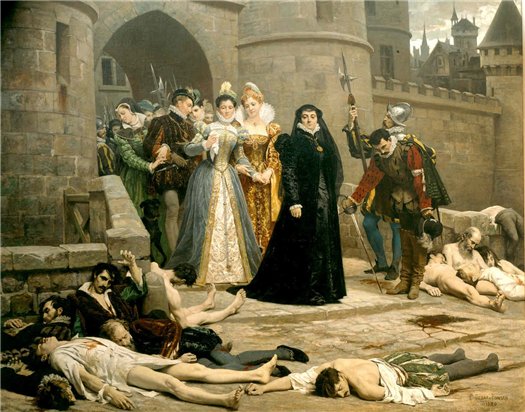 Three days later, one of the Huguenot leaders, Admiral Gaspard Coligny, on his way from the Louvre, was wounded in the arm by a shot from the window of a nearby building. The smoking arch was left in the window, but the shooter managed to escape. Coligny was carried to his apartment, where surgeon Ambroise Paré removed the bullet from his elbow and amputated one of his fingers. Catherine was said to have reacted to this incident without emotion. She visited Coligny and tearfully promised to find and punish her attacker. Many historians blamed Catherine for the attack on Coligny. Others point to the de Guise family or to a Spanish-papal conspiracy that tried to end Coligny's influence over the king. The name of Catherine de Medici is associated with one of the bloodiest events in the history of France - St. Bartholomew's Night. The massacre, which began two days later, tarnished Catherine's reputation indelibly. There is no doubt that she was behind the decision on August 23, when Charles IX ordered: “Then kill them all, kill them all!” The train of thought was clear, Catherine and her Italian advisers (Albert de Gondi, Lodovico Gonzaga, Marquis de Villars) expected a Huguenot uprising after the assassination attempt on Coligny, so they decided to strike first and destroy the Huguenot leaders who came to Paris for the wedding of Margaret of Valois and Henry of Navarre . The St. Bartholomew massacre began in the first hours of August 24, 1572. The king's guards burst into Coligny's bedroom, killed him and threw his body out of the window. At the same time, the sound of the church bell was a conventional sign for the beginning of the murders of the Huguenot leaders, most of whom died in their own beds. The king's newly minted son-in-law, Henry of Navarre, was faced with a choice between death, life imprisonment and conversion to Catholicism. He decided to become a Catholic, after which he was asked to stay in the room for his own safety. All the Huguenots inside and outside the Louvre were killed, and those who managed to escape into the street were shot by the royal riflemen who were waiting for them. The Parisian massacre continued for almost a week, spreading across many provinces of France, where indiscriminate killings continued. According to historian Jules Michelet, "Bartholomew's Night was not a night, but a whole season." This massacre delighted Catholic Europe, and Catherine enjoyed the praise. On September 29, when Henry of Bourbon knelt before the altar like a good Catholic, she turned to the ambassadors and laughed. From this time on, the “black legend” of Catherine, the evil Italian queen, began. An interesting point: Karl once publicly accused his mother of being to blame for organizing St. Bartholomew’s Night, and, moreover, declared that he would now rule himself without her help. The scandal ended with a dinner with reconciliation, but it was after this dinner that Karl finally fell ill and fell ill.
Three days later, one of the Huguenot leaders, Admiral Gaspard Coligny, on his way from the Louvre, was wounded in the arm by a shot from the window of a nearby building. The smoking arch was left in the window, but the shooter managed to escape. Coligny was carried to his apartment, where surgeon Ambroise Paré removed the bullet from his elbow and amputated one of his fingers. Catherine was said to have reacted to this incident without emotion. She visited Coligny and tearfully promised to find and punish her attacker. Many historians blamed Catherine for the attack on Coligny. Others point to the de Guise family or to a Spanish-papal conspiracy that tried to end Coligny's influence over the king. The name of Catherine de Medici is associated with one of the bloodiest events in the history of France - St. Bartholomew's Night. The massacre, which began two days later, tarnished Catherine's reputation indelibly. There is no doubt that she was behind the decision on August 23, when Charles IX ordered: “Then kill them all, kill them all!” The train of thought was clear, Catherine and her Italian advisers (Albert de Gondi, Lodovico Gonzaga, Marquis de Villars) expected a Huguenot uprising after the assassination attempt on Coligny, so they decided to strike first and destroy the Huguenot leaders who came to Paris for the wedding of Margaret of Valois and Henry of Navarre . The St. Bartholomew massacre began in the first hours of August 24, 1572. The king's guards burst into Coligny's bedroom, killed him and threw his body out of the window. At the same time, the sound of the church bell was a conventional sign for the beginning of the murders of the Huguenot leaders, most of whom died in their own beds. The king's newly minted son-in-law, Henry of Navarre, was faced with a choice between death, life imprisonment and conversion to Catholicism. He decided to become a Catholic, after which he was asked to stay in the room for his own safety. All the Huguenots inside and outside the Louvre were killed, and those who managed to escape into the street were shot by the royal riflemen who were waiting for them. The Parisian massacre continued for almost a week, spreading across many provinces of France, where indiscriminate killings continued. According to historian Jules Michelet, "Bartholomew's Night was not a night, but a whole season." This massacre delighted Catholic Europe, and Catherine enjoyed the praise. On September 29, when Henry of Bourbon knelt before the altar like a good Catholic, she turned to the ambassadors and laughed. From this time on, the “black legend” of Catherine, the evil Italian queen, began. An interesting point: Karl once publicly accused his mother of being to blame for organizing St. Bartholomew’s Night, and, moreover, declared that he would now rule himself without her help. The scandal ended with a dinner with reconciliation, but it was after this dinner that Karl finally fell ill and fell ill. 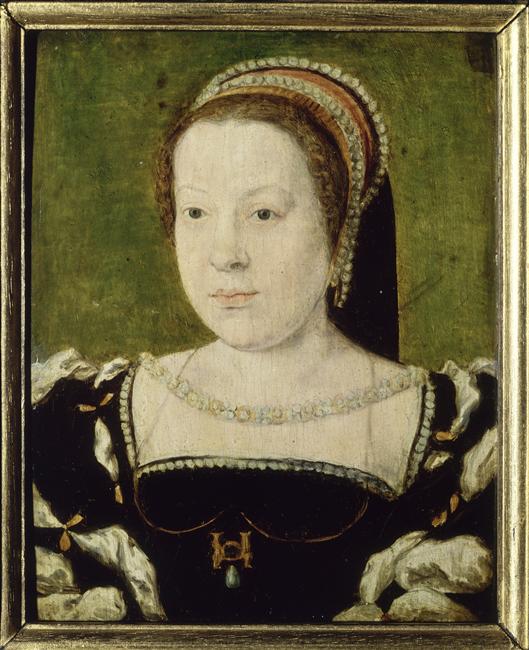 With the death of twenty-three-year-old Charles IX, Catherine faced a new crisis. With dying words Catherine's dying son were: “Oh, my mother...” The day before his death, he appointed his mother as regent, since his brother, the heir to the French throne, the Duke of Anjou, was in Poland, becoming its king. In her letter to Henry, Catherine wrote: “I am heartbroken... My only consolation is to see you here soon, as your kingdom requires and in good health, because if I lose you too, I will bury myself alive with you.” Henry was Catherine's beloved son. Unlike his brothers, he took the throne at an adult age. He was also the healthiest of all, although he also had weak lungs and suffered from constant fatigue. Catherine could not control Henry the way she did with Francis and Charles. Her role during Henry's reign was that of a state executive and traveling diplomat. In addition, there were persistent rumors that Heinrich did not let a single handsome young man through, and this plunged his mother into despair. During the reign of Henry III civil wars in France often descended into anarchy, supported by the struggle for power between the high nobility of France on the one hand and the clergy on the other. A new destabilizing component in the kingdom was the youngest son of Catherine de Medici - Francois, Duke of Alençon. He plotted to seize the throne while Henry was in Poland and later continued to disturb the peace in the kingdom, using every opportunity. The brothers hated each other. Since Henry had no children, Francois was the legal heir to the throne. Once Catherine had to lecture him for six hours about his, Francois, behavior. But the ambitions of the Duke of Alençon (later of Anjou) brought him closer to misfortune. His ill-equipped campaign in the Netherlands in January 1583 ended with the destruction of his army in Antwerp. Antwerp was the end military career Francois. Catherine de Medici wrote in a letter to him: “... it would have been better for you to die in your youth. Then you would not have caused the death of so many brave noble people.” Another blow befell him when Elizabeth I officially broke off her engagement to him after the Antwerp massacre. On June 10, 1584, François died of exhaustion after failures in the Netherlands. The day after her son’s death, Catherine wrote: “I am so unhappy, living long enough, seeing so many people die before me, although I understand that God’s desire must be obeyed, that He owns everything and what He lends us only so far.” as long as He loves the children He gives us.” Death of himself youngest son Catherine became a real disaster for her dynastic plans. Henry III had no children, and it seemed unlikely that he would ever have any. According to the Salic Law, the former Huguenot Henry of Bourbon, King of Navarre, became the heir to the French crown.
With the death of twenty-three-year-old Charles IX, Catherine faced a new crisis. With dying words Catherine's dying son were: “Oh, my mother...” The day before his death, he appointed his mother as regent, since his brother, the heir to the French throne, the Duke of Anjou, was in Poland, becoming its king. In her letter to Henry, Catherine wrote: “I am heartbroken... My only consolation is to see you here soon, as your kingdom requires and in good health, because if I lose you too, I will bury myself alive with you.” Henry was Catherine's beloved son. Unlike his brothers, he took the throne at an adult age. He was also the healthiest of all, although he also had weak lungs and suffered from constant fatigue. Catherine could not control Henry the way she did with Francis and Charles. Her role during Henry's reign was that of a state executive and traveling diplomat. In addition, there were persistent rumors that Heinrich did not let a single handsome young man through, and this plunged his mother into despair. During the reign of Henry III civil wars in France often descended into anarchy, supported by the struggle for power between the high nobility of France on the one hand and the clergy on the other. A new destabilizing component in the kingdom was the youngest son of Catherine de Medici - Francois, Duke of Alençon. He plotted to seize the throne while Henry was in Poland and later continued to disturb the peace in the kingdom, using every opportunity. The brothers hated each other. Since Henry had no children, Francois was the legal heir to the throne. Once Catherine had to lecture him for six hours about his, Francois, behavior. But the ambitions of the Duke of Alençon (later of Anjou) brought him closer to misfortune. His ill-equipped campaign in the Netherlands in January 1583 ended with the destruction of his army in Antwerp. Antwerp was the end military career Francois. Catherine de Medici wrote in a letter to him: “... it would have been better for you to die in your youth. Then you would not have caused the death of so many brave noble people.” Another blow befell him when Elizabeth I officially broke off her engagement to him after the Antwerp massacre. On June 10, 1584, François died of exhaustion after failures in the Netherlands. The day after her son’s death, Catherine wrote: “I am so unhappy, living long enough, seeing so many people die before me, although I understand that God’s desire must be obeyed, that He owns everything and what He lends us only so far.” as long as He loves the children He gives us.” Death of himself youngest son Catherine became a real disaster for her dynastic plans. Henry III had no children, and it seemed unlikely that he would ever have any. According to the Salic Law, the former Huguenot Henry of Bourbon, King of Navarre, became the heir to the French crown. 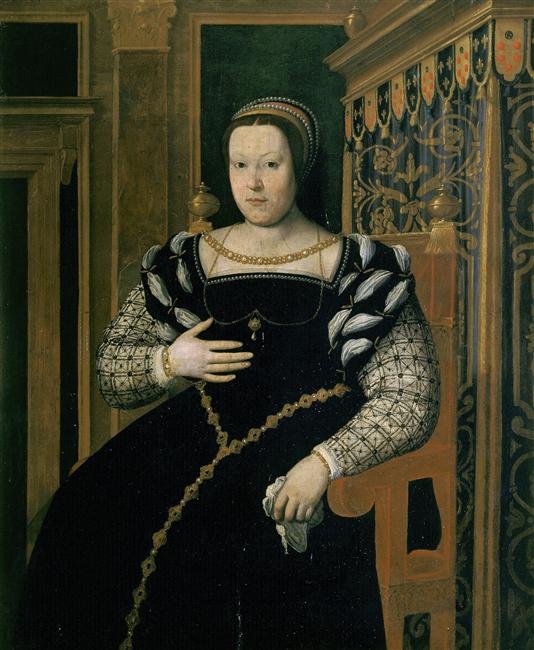 The behavior of Catherine's youngest daughter, Marguerite de Valois, annoyed her mother just as much as Francois's behavior. One day in 1575, Catherine yelled at Margarita because of rumors that she had a lover. Another time, the king even sent people to kill Marguerite de Bussy’s lover (a friend of François Alençon), but he managed to escape. In 1576, Henry accused Margaret of having an inappropriate relationship with a lady of the court. Later, in her memoirs, Margarita claimed that if it were not for Catherine’s help, Henry would have killed her. In 1582, Margarita returned to the French court without her husband and soon she began to behave very scandalously, changing lovers, Catherine had to resort to the help of the ambassador to appease Henry of Bourbon and return Margarita to Navarre. She reminded her daughter that her own behavior as a wife was impeccable, despite all the provocations. But Margarita was unable to follow her mother's advice. In 1585, after Margaret was rumored to have tried to poison and shoot her husband, she fled Navarre again. This time she headed to her own Agen, from where she soon asked her mother for money, which she received in an amount sufficient for food. However, soon she and her next lover, persecuted by the inhabitants of Agen, had to move to the Karlat fortress. Catherine asked Henry to take immediate action before Margaret disgraced them again. In October 1586, Margarita was locked in the castle d'Usson. Margarita's lover was executed before her eyes. Catherine excluded her daughter from her will and never saw her again.
The behavior of Catherine's youngest daughter, Marguerite de Valois, annoyed her mother just as much as Francois's behavior. One day in 1575, Catherine yelled at Margarita because of rumors that she had a lover. Another time, the king even sent people to kill Marguerite de Bussy’s lover (a friend of François Alençon), but he managed to escape. In 1576, Henry accused Margaret of having an inappropriate relationship with a lady of the court. Later, in her memoirs, Margarita claimed that if it were not for Catherine’s help, Henry would have killed her. In 1582, Margarita returned to the French court without her husband and soon she began to behave very scandalously, changing lovers, Catherine had to resort to the help of the ambassador to appease Henry of Bourbon and return Margarita to Navarre. She reminded her daughter that her own behavior as a wife was impeccable, despite all the provocations. But Margarita was unable to follow her mother's advice. In 1585, after Margaret was rumored to have tried to poison and shoot her husband, she fled Navarre again. This time she headed to her own Agen, from where she soon asked her mother for money, which she received in an amount sufficient for food. However, soon she and her next lover, persecuted by the inhabitants of Agen, had to move to the Karlat fortress. Catherine asked Henry to take immediate action before Margaret disgraced them again. In October 1586, Margarita was locked in the castle d'Usson. Margarita's lover was executed before her eyes. Catherine excluded her daughter from her will and never saw her again. 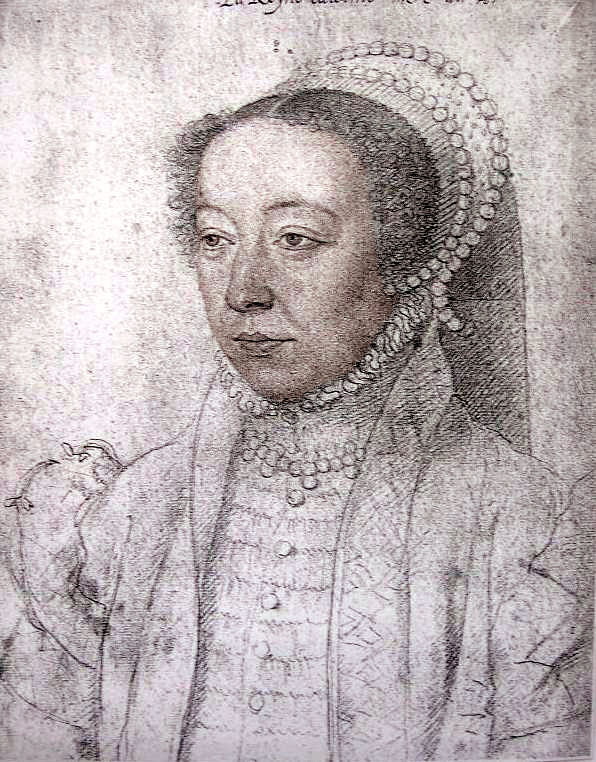 In 1588 the culmination of the religious wars began. There was a whiff of rebellion in Paris. Leaflets about “His Majesty the Hermaphrodite” appeared, and an image of the Queen Mother, that “old witch” who gave birth to a perverted son, was burned. The day came when cries were heard in front of the Louvre: “Down with Valois! Death to Valois! Thus, for the first time in a thousand years, the throne of France began to shake. With the knowledge of Henry III, Cardinal de Guise was killed, he was brutally stabbed to death, his body was thrown next to the body of his brother, both corpses were cut into pieces and burned in the fireplace of the castle, so that later they would not be worshiped as martyrs. As soon as Guise was sent to the next world, the king went down to his mother, who occupied the apartment under his own and who, most likely, should have heard the noise at the time of the murder. At the patient's bedside sat the doctor Filipe Cavriana, a spy for the Grand Duke of Tuscany, to whom he told about this scene. Henry asked him how the queen was feeling. The doctor told him that she was resting after taking medication. Then the king approached old woman and greeted her very confidently: “Good afternoon, Madam, excuse me. Monsieur de Guise is dead; There's no point in talking about him anymore. I ordered him to be killed, ahead of his intentions towards me.” He recalled what insults he had to endure, and all that he knew about the incessant intrigues of his enemy. To save his power, his life and his state, he had to take these extreme measures. God himself helped him in this; With that, he took his leave, telling his mother that he was going to mass to thank heaven for the happy outcome of this punishment. “I want to be a king, and not a prisoner and a slave, as I was, from May 13 until this hour, when I again become a king and master.” With these words he left. The Queen was too weak to answer him. “She almost died,” said the doctor, “from terrible grief,” and adds: “I am afraid that the departure of Madame Princess of Lorraine [to Tuscany] and this funeral of the Duke of Guise may worsen her condition.” On the morning of January 5, on the eve of Epiphany, she wanted to write a will and confess. She lived out her last minutes. Her loved ones were worried. Let us give the floor to the eyewitness of this event, Etienne Pasquier: “There is something remarkable in her death. She always had great faith in fortune tellers, and since she had once been told that in order to live long she had to beware of some Saint Germain, she especially did not want to go to Saint Germain-en-Laye, for fear of meeting her death, and even, in order not to live in the Louvre, which belongs to the parish of Saint-Germain de l'Auxerrois, she ordered the construction of her palace in the parish of Saint-Eustache, where she lived. Finally, God wanted that, dying, she did not live in Saint-Germain, but the first confessor of the king, de Saint-Germain, became her comforter." An autopsy of the corpse revealed a terrible general condition of the lungs with a purulent abscess on the left side. According to modern researchers, possible reason Catherine de Medici's death was due to pleurisy. “Those who were close to her believed that her life was shortened by frustration because of the actions of her son,” believed one of the chroniclers. Since Paris was held by enemies of the crown at that time, they decided to bury Catherine in Blois. She was later reburied in the Parisian Abbey of Saint-Denis. In 1793, during the Great french revolution, the revolutionary crowd threw her remains, as well as the remains of all French kings and queens, into a common grave
In 1588 the culmination of the religious wars began. There was a whiff of rebellion in Paris. Leaflets about “His Majesty the Hermaphrodite” appeared, and an image of the Queen Mother, that “old witch” who gave birth to a perverted son, was burned. The day came when cries were heard in front of the Louvre: “Down with Valois! Death to Valois! Thus, for the first time in a thousand years, the throne of France began to shake. With the knowledge of Henry III, Cardinal de Guise was killed, he was brutally stabbed to death, his body was thrown next to the body of his brother, both corpses were cut into pieces and burned in the fireplace of the castle, so that later they would not be worshiped as martyrs. As soon as Guise was sent to the next world, the king went down to his mother, who occupied the apartment under his own and who, most likely, should have heard the noise at the time of the murder. At the patient's bedside sat the doctor Filipe Cavriana, a spy for the Grand Duke of Tuscany, to whom he told about this scene. Henry asked him how the queen was feeling. The doctor told him that she was resting after taking medication. Then the king approached old woman and greeted her very confidently: “Good afternoon, Madam, excuse me. Monsieur de Guise is dead; There's no point in talking about him anymore. I ordered him to be killed, ahead of his intentions towards me.” He recalled what insults he had to endure, and all that he knew about the incessant intrigues of his enemy. To save his power, his life and his state, he had to take these extreme measures. God himself helped him in this; With that, he took his leave, telling his mother that he was going to mass to thank heaven for the happy outcome of this punishment. “I want to be a king, and not a prisoner and a slave, as I was, from May 13 until this hour, when I again become a king and master.” With these words he left. The Queen was too weak to answer him. “She almost died,” said the doctor, “from terrible grief,” and adds: “I am afraid that the departure of Madame Princess of Lorraine [to Tuscany] and this funeral of the Duke of Guise may worsen her condition.” On the morning of January 5, on the eve of Epiphany, she wanted to write a will and confess. She lived out her last minutes. Her loved ones were worried. Let us give the floor to the eyewitness of this event, Etienne Pasquier: “There is something remarkable in her death. She always had great faith in fortune tellers, and since she had once been told that in order to live long she had to beware of some Saint Germain, she especially did not want to go to Saint Germain-en-Laye, for fear of meeting her death, and even, in order not to live in the Louvre, which belongs to the parish of Saint-Germain de l'Auxerrois, she ordered the construction of her palace in the parish of Saint-Eustache, where she lived. Finally, God wanted that, dying, she did not live in Saint-Germain, but the first confessor of the king, de Saint-Germain, became her comforter." An autopsy of the corpse revealed a terrible general condition of the lungs with a purulent abscess on the left side. According to modern researchers, possible reason Catherine de Medici's death was due to pleurisy. “Those who were close to her believed that her life was shortened by frustration because of the actions of her son,” believed one of the chroniclers. Since Paris was held by enemies of the crown at that time, they decided to bury Catherine in Blois. She was later reburied in the Parisian Abbey of Saint-Denis. In 1793, during the Great french revolution, the revolutionary crowd threw her remains, as well as the remains of all French kings and queens, into a common grave 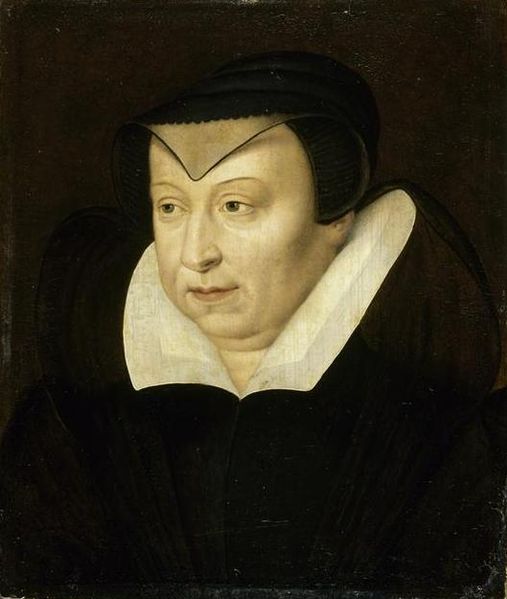 Eight months after Catherine's death, everything that she so strived for and dreamed of during her life was reduced to zero when the religious fanatic monk Jacques Clement stabbed to death her beloved son and the last Valois, Henry III. The servant reported that Catherine, just before her death, quietly said: “I was crushed by the rubble of the house.” Sources.
Eight months after Catherine's death, everything that she so strived for and dreamed of during her life was reduced to zero when the religious fanatic monk Jacques Clement stabbed to death her beloved son and the last Valois, Henry III. The servant reported that Catherine, just before her death, quietly said: “I was crushed by the rubble of the house.” Sources.
At the age of 14, Catherine was married to Henry de Valois, the second son of Francis I, King of France, for whom this union was beneficial primarily due to the support that the Pope could provide to his military campaigns in Italy.
The bride's dowry amounted to 130,000 ducats, and extensive possessions that included Pisa, Livorno and Parma.
Contemporaries described Elizabeth as a slender red-haired girl, short in stature and with a rather ugly face, but very expressive eyes - a Medici family trait.
Young Catherine so wanted to impress the exquisite French court that she resorted to the help of one of the most famous Florentine craftsmen, who made high-heeled shoes especially for her petite customer. It must be admitted that Catherine achieved what she wanted; her presentation to the French court created a real success.
The wedding took place on October 28, 1533 in Marseille.
Europe has not seen such a gathering of representatives of the highest clergy, perhaps, since the days of medieval cathedrals: Pope Clement VII himself attended the ceremony, accompanied by his many cardinals. The celebration was followed by 34 days of continuous feasts and balls.
However, the holidays soon died down, and Catherine was left alone with her new role.
The French court has always been famous for its sophistication, nobility of manners and brilliantly educated and sophisticated ladies. Under the influence of a revived interest in antiquity, the courtiers of Francis I spoke to each other in Latin and Greek, read Ronsard's poems and admired the sculptural sculptures of Italian masters. In merchant Florence, as opposed to France, the fathers of families were not concerned with giving their wives and daughters such a comprehensive education, as a result of which in the first years of her life at the French court, Catherine felt like an ignoramus who did not know how to elegantly construct phrases and made many mistakes in letters. She felt isolated from society and suffered severely from loneliness and from the hostility shown to her by the French, who contemptuously called the daughter-in-law of Francis I “Italian” and “merchant’s wife.” The only friend that young Catherine found in France was her father-in-law.
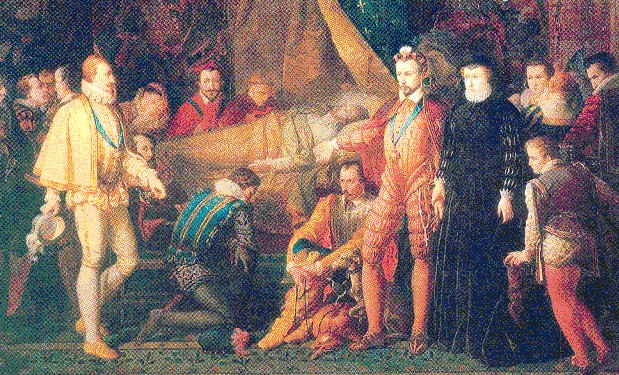
In 1536, the heir to the French throne died unexpectedly.
According to the official version, death was caused by a cold, which the Dauphin caught after swimming in ice water after playing ball. According to another, the crown prince was poisoned by Catherine, who desired the accession of her husband to the throne. Fortunately, these rumors did not in any way affect the warm relationship between Francis I and his daughter-in-law, but be that as it may, since then the Florentine woman has firmly established herself as a poisoner.
Under pressure from her husband, who wanted to consolidate her position with the birth of an heir, Catherine, who had not yet produced any offspring for him, was treated for a long time and in vain by all kinds of magicians and healers with one single goal - to become pregnant.
Born in 1537 bastard Henry from a certain young lady named Philippa Duchi. This event finally confirmed that it was Catherine who was infertile. At court they started talking about the possibility of divorce.
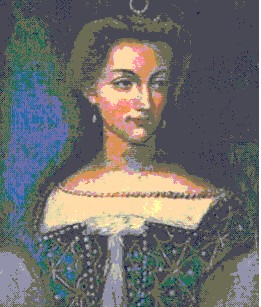 As you know, misfortune does not come alone, and Catherine was faced with another test: a woman appeared in the life of Henry de Valois, whom many considered the true ruler of France over the next few years. We are talking about Diane de Poitiers, Henry's favorite, who was a full 20 years older than her crowned lover. Probably due to the difference in age, the relationship between Henry and Diana was based more on reason than on sensual passion. Henry highly valued Diana's wisdom and foresight, and listened carefully to her advice before making important political decisions. Both shared a passion for hunting. Many paintings have come down to us in which lovers are depicted in the image of the Roman goddess-hunter Diana and the young god Apollo.
As you know, misfortune does not come alone, and Catherine was faced with another test: a woman appeared in the life of Henry de Valois, whom many considered the true ruler of France over the next few years. We are talking about Diane de Poitiers, Henry's favorite, who was a full 20 years older than her crowned lover. Probably due to the difference in age, the relationship between Henry and Diana was based more on reason than on sensual passion. Henry highly valued Diana's wisdom and foresight, and listened carefully to her advice before making important political decisions. Both shared a passion for hunting. Many paintings have come down to us in which lovers are depicted in the image of the Roman goddess-hunter Diana and the young god Apollo.
The deceived wife, forgotten by everyone, had no choice but to come to terms with her humiliation. Overcoming herself, Catherine, like a true Medici, nevertheless managed to step on the throat of her pride and win over her husband’s mistress, who was quite happy with such friendship, because the appearance of another, more prolific and less friendly wife could put her position at court in jeopardy.
For a long time, all three formed a rather strange love triangle: Diana occasionally pushed Henry to her wife’s bed, and Catherine, receiving him, was tormented by jealousy and her own powerlessness to change anything.
Comparison with the lovely Diana was clearly not in Catherine’s favor. She was never a beauty, but with age she gained considerable weight, and, as her contemporaries put it, she looked more and more like her uncle. The latter, of course, could not possibly be a compliment. A particularly repulsive feature was her excessively high forehead. Gossips they claimed that a second face could easily fit between her eyebrows and the roots of her hair. In all likelihood, this was a consequence of hair loss, which Catherine carefully concealed by using wigs.
The fact that Catherine stoically experienced her husband’s betrayal does not mean that she did not try to do something to get rid of her rival.
Echoes of a palace scandal have reached us, in which, in addition to Catherine, a certain Duke of Nemours was involved. From the letters of the participants in this story, it is known that, apparently, Catherine asked the Duke, seizing the moment, in the midst of fun, under the guise of a cute prank, to throw a glass of water in Diana’s face. The “joker” was not supposed to know that the glass should have had burnt lime instead of water.
The plot was discovered, and Nemur was exiled, but later pardoned and returned to court.
The news that Catherine was pregnant came as a complete surprise to everyone. The miraculous healing of the barren Dauphine was attributed to Nostradamus, a physician and astrologer who was part of Catherine's close circle of confidants.
Her firstborn, named Francis after his grandfather, was born in 1543.
Francis I died in 1549. Henry II ascended the throne, and Catherine was proclaimed Queen of France.
She reinforced her position with the birth of several more heirs.
10 years later, in 1559, Henry died as a result of an injury received in a tournament.
In all of France, perhaps, there was no person who mourned the death of the king so inconsolably as the beautiful Diana.
Catherine finally had the opportunity to give vent to her pent-up anger and get even with her rival. She demanded that de Poitiers return the jewels belonging to the crown to her, and also leave her home - the Chanonceau castle.
With the accession to the throne of the sickly and weak 15-year-old Francis II, Catherine became regent and de facto ruler of the state.
The courtiers, who did not like Catherine the heir, did not accept her as their empress. Her enemies called her the “black queen,” referring to the constant mourning clothes that Catherine donned after the death of her husband and did not take off until the end of her days. For many centuries, she gained the reputation of a poisoner and an insidious, vengeful intriguer who mercilessly dealt with her enemies.
One of the bloodiest events in the history of France is associated with the name of Catherine - St. Bartholomew's Night. 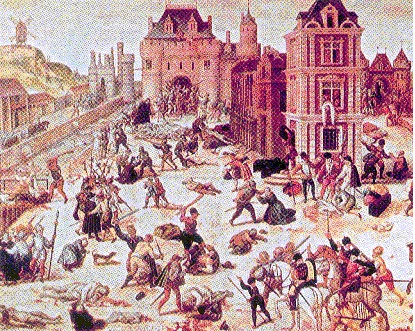
According to the generally accepted version, Catherine set a trap for the Huguenot leaders by inviting them to Paris for her daughter's wedding to Henry of Navarre.
On the night of August 23-24, 1572, with the ringing of bells, thousands of citizens filled the streets of Paris. A horrific bloody massacre ensued.
According to rough estimates, about 3,000 Huguenots were killed in Paris that night. One of the victims was their leader, Admiral Coligny.
The wave of violence that originated in the capital also swept the outskirts. In a bloody orgy that lasted a week, another 8,000 thousand Huguenots were killed throughout France.
It is possible that the brutal massacre of the opponents was actually carried out on the orders of Catherine, but there is, however, the possibility that she was not aware of the impending attack, and in the chaos that followed, she had no choice but to accept take responsibility for what happened, so as not to admit the loss of control over the situation in the state.
Was Catherine really exactly what her spiteful critics described her as? Or has only a distorted image of this personality reached us?
Few people, perhaps, know that Catherine was a great lover of art and a philanthropist. It was she who came up with the idea of building a new wing of the Louvre and the Tuileries Castle. Catherine's library consisted of hundreds of interesting books and rare ancient manuscripts. It was thanks to her that the French court discovered the delights of Italian cuisine, including artichokes, broccoli and several varieties of spaghetti.
With her light hand the French fell in love with ballet (baletto), and ladies began to wear corsets and underwear - Catherine was a passionate lover of horse riding and became the first woman to wear pantaloons, despite protests from the clergy.
It is also impossible not to admire Catherine the Mother. Regardless of the methods she used in the fight against her opponents, she was, first of all, a friend, support and support to her three sons who ascended the French throne: Francis II, Charles IX and Henry III.
The “black queen” died at the age of 70 at the Château de Blois and was buried next to her husband, Henry II, in the Abbey of Saint Denis. Catherine was lucky enough to die in ignorance, she never learned that the last of her ten offspring, Henry III, was killed shortly after her death, and everything that she had fought for for many years had sunk into oblivion. The de Valois dynasty ceased to exist.
Ambitious, cunning and superstitious, like all Italians, Catherine de Medici, wife of the French king Henry II, for twenty-eight years controlled the destinies of her second fatherland with the help of all sorts of intrigues and intrigues, which, in her opinion, were supposed to increase the prestige of the house of Valois, at the end of her life I was forced to become convinced of the futility of my efforts and the complete destruction of my hopes.
Narrow selfishness, cruelty and indiscriminate choice of means when wanting to get rid of her political opponents, constant fluctuations in matters of religion, shocked by the Reformation, which entailed the terrible “Night of Bartholomew,” betrayed her name to eternal shame.
Catherine, the daughter of Pope Leo X's nephew Lorenzo II de' Medici, Duke of Urbana and Florence, and Madeleine de la Tour, Countess of Boulogne, was born in Florence on April 15, 1519. A few days after her birth, first her mother and then her father went to better world. Catherine's childhood, which coincided with the turbulent years of political life in Florence, was surrounded by all sorts of dangers. Having ascended the papal throne in 1523, after the death of Adrian VI, Cardinal Giulio de' Medici, who took the name Clement VII, wished to rule republican Florence from Rome without limit, resorting to means opposite to those that had once created the popularity of the house of Medici. The indignation of Florence caused by this course of action ultimately ended in the triumph of the pope, which destroyed its political freedom and independence. During the troubled years, Catherine remained in her homeland without a break, imprisoned by the verdict of the provisional government in the monastery of Santa Lucia. The Florentines looked at her as a hostage, certainly wanting to keep her within the walls of the city. She was strictly watched, not allowed to take a single free step outside the walls of the monastery, and once they even offered to expose her to enemy guns or give her to rude soldiers. At that time, Catherine was only 9 years old. Thus, with youth she is used to seeing struggle around her political parties, and fear of them became a constant feeling in her.
But then Florence fell, and by order of Clement VII, the young Duchess of Urbino and Florence was transported to Rome, where, after the supervision of a suspicious democracy, she fell into the hands of her uncle, who looked at her only as a tool for expanding his political connections. To this end, he set about finding a suitable match for her. Soon, at his request, she was engaged to the young Prince of Orange, Philibert of Chalons, as a reward for her devotion to the house of Medici, but his death in one of the battles prevented the implementation of the papal project. Then John Stuart, Duke of Albany, Catherine's maternal uncle, who enjoyed the favors of the French king Francis I, offered the hand of his niece for his second son, Duke Henry of Orleans. With this combination, Pope Clement VII promised Francis I his support for the conquest of the Duchy of Milan. The marriage was immediately decided, and Catherine went to France, accompanied by the Duke d'Albani and a large retinue. A brilliant flotilla awaited them in Porto Venere. The galley intended for the future Duchess of Orleans sparkled with precious jewelry; the sails were woven from silk; on the draperies, furniture, carpets covering the deck, the Medici coats of arms with the motto: “Light and peace” could be seen; the entire crew was luxuriously outfitted. It seemed that Cleopatra was again in a hurry to meet Anthony! In Livorno, the flotilla was joined by Clement VII, who occupied the galley of the Duke d'Albani, entirely draped in golden cloth, lined with purple satin. The squadron entered Marseille harbor on the morning of October 11, 1535. All French ships were decorated with flags, port and fortress guns saluted, merging o with with the roar of church bells welcoming the bride of the royal son, Francis I arrived in Marseille the next day with a brilliant retinue that eclipsed the papal luxury, and after him arrived his second wife, Queen Eleanor of Austria, surrounded by a flower garden of young ladies-in-waiting.
The wedding ceremony took place on October 27. The newlyweds were still so young - Catherine was 14 years old, Henry was several months older - that the king and queen decided to place them in different rooms, but the pope protested and united the spouses on one bed. As a dowry for her husband, Catherine brought 100,000 gold ducats, for the same amount of outfits and the counties of Auvergne and Lorage. The festivities lasted 34 days and were distinguished by extraordinary splendor. Henry of Orleans, a little dark, although this suited him very well, slender and amiable, attracted all eyes, as did Catherine, who had a charming figure, lively eyes and a somewhat pale complexion, which, however, did not deprive him of his pleasantness. Although she often changed her outfits and coiffures, they all suited her so well that it is difficult to determine which suited her best. Besides all this, she had surprisingly tiny legs, and she loved to show them off at every opportunity. Contemporaries unanimously admired the brilliant education of the young Duchess of Orleans, who really brought to her new fatherland a lot of enlightened love for the arts and educated taste, for a long time which were, as it were, hereditary qualities of the House of Medici. In addition to them, Catherine inherited all the other virtues and vices of her ancestors. She adored gold, like old Cosimo I, and lavished it, like Pietro I and Cosimo II, her great-grandfathers; she was magnificent, like her great-grandfather Lorenzo I, and just like him, she knew a lot about politics, although she lacked either his magnanimity or generosity; her ambition was in no way inferior to that of her grandfather, Pietro II, and if she wanted to rule, she, like him, did not make a difference between legal and illegal methods to achieve certain goals; following the example of her father, Lorenzo II, she loved entertainment, but valued it only in accordance with the amount of expenses. Catherine expressed the dominant thought of her entire life in a few words: “Come what may, I want to reign!” Two revolutions later, Louis XV repeated this famous aphorism, slightly changing the wording: “After us, even a flood!”
Taking this opportunity, a long line of her fellow countrymen followed Catherine: artists, architects, doctors, alchemists, comedians, and finally, simply adventurers, whom France received very cordially and who soon, feeling at home in it, created a considerable number of misunderstandings, serving and obeying only one Medici daughter. At her first sign, all kinds of Rene and Ruggieri prepared poisonous drinks, foods, gloves, flowers, etc. Superstitious Catherine never undertook anything without consulting astrologers, and her greatest confidence was in the famous Nostradamus - later physician to Charles IX - who with amazing accuracy predicted, among many other things, the death of Henry II and the horrors of Bartholomew's Night.
From her first appearance at the French court, Catherine showed extraordinary resourcefulness in her ability to get along among all kinds of parties and ingratiate herself with people who were clearly hostile to her interests. First of all, of course, it was necessary to please his father-in-law. Surrounded by the most beautiful ladies of the court, hunting deer with them, he did not pay the slightest attention to his pretty daughter-in-law. The Florentine woman's self-esteem suffered greatly. Oh, she will make him pay attention to herself! Francis I imagined that he was an unusually skillful politician and diplomat - although it is difficult to find a second sovereign who committed so many of the gravest mistakes - and the cunning Catherine cleverly took advantage of his vanity. She began to admire his genius, approved of all his projects that came to his mind, and the old king, succumbing to the bait, from then on almost never parted with his daughter-in-law, giving her first place on holidays and hunts, to the envy of others. It was much more difficult to get along with her husband, but even here Catherine was not lost. Henry of Orleans, a brave soldier and an excellent horseman, but deprived of any independence, distinguished by amazing laziness and slowness of mind, did little with his wife.
During this era, the French court was divided into two parties: the Duchess d'Etampes, the king's favorite, and the mistress of Catherine's husband, who was old enough to be his mother, Diana de Poitiers. The first party did not pose a danger, but the second had to be taken into account for two reasons. Diana was the only woman to whom everyone yielded, before whom all doors were opened, who dared to order Catherine to leave her alone with Henry, and she had to obey “The favorite,” says one of the contemporaries, “took control of Henry’s heart to such an extent that. when the Duchess of Orleans wanted to be with her husband, she had to ask Diana for permission, and she only had to say: “Today you must go to your wife,” so that Henry would meekly obey her orders." In addition, too influential nobles were grouped around this favorite: Guise, Constable Montmorency and others, who dreamed of becoming the head of the administration of France with the accession of the frail and weak-willed Dauphin. But Catherine herself wanted to reign, and in her they acquired a hidden enemy, although outwardly she seemed to be their well-wisher. Henry's passion for his faded mistress in the eyes of his wife was an insult that women never forgive, but the young Florentine, instead of bursting into reproaches, suppressed her feelings of jealousy and redoubled her courtesies with her rival, soon becoming her closest friend, at the same time time, behaving so cunningly with her husband that he openly admitted that he did not feel as good anywhere as in his wife’s bed. Thus, both the wolves were fed and the sheep were safe.
Of all those around the young Duchess of Orleans in this era, the greatest influence on her was Gonto-Gondi, the future educator of Charles IX, who was later granted marshal by Catherine with the title of de Retz, and the Cardinal of Lorraine, Duke Charles of Guise. The latter at first even enjoyed her exceptional favor, as evidenced by Catherine’s note to Constable Montmorency. “He will come to me again today,” she writes, “but tomorrow we will part. Oh, I so wish that business would allow him to postpone his departure and he could stay with me longer.” However, the cardinal is the only stain on her reputation as a wife.
Being of a cheerful disposition, Catherine willingly laughed, sincerely or insincerely - that’s another question, and she loved to speak evil among the court ladies, diligently doing embroidery, and mastering the needle perfectly. Among the holidays, balls, carousels and various amusements, the Duchess of Orleans seemed to devote herself wholeheartedly to entertainment. No one imagined that at that time she was already considering means to achieve the throne. The only obstacle was the Dauphin. And after three years of hypocrisy and intrigue, she finally overcame him without arousing any suspicion: in 1536, the Dauphin suddenly died, and Henry of Orleans unexpectedly became heir to the throne. It goes without saying that the crime conceived by Catherine was carried out by her faithful Florentines, whom she generously rewarded and sometimes even appointed to important government positions, without thereby arousing sympathy from the French.
Francis I is dead, long live Henry II! It seemed that all of Catherine’s ambitious dreams had come true, and yet she felt far from calm. 10 years have passed since the wedding, and the queen remained childless. At the court that was at the feet of Diana de Poitiers, they were seriously talking about divorce, considering Catherine to be the culprit of infertility. The House of Valois needs an heir. The rosy future that the Medici daughter had once dreamed of was now pictured to her in the darkest colors. Finally, in 1544, the queen breathed freely: France solemnly celebrated the birth of the Dauphin Francis, and Catherine was saved. A year later, she gave her husband a daughter, Elizabeth (Isabella), later the wife of the Spanish King Philip II, and then five more children: Claudia (1547), who married Charles of Guise and died in childbirth, Charles of Orleans (1550), Henry of Anjou (1551) , Margaret (1552), the future wife of Henry of Navarre, and Francis of Alençon (1554). Some explained the late fertility of the queen by the heredity inherent in all women of the house of Medici, others - by the advice of the royal physician and at the same time astrologer Fernel. The birth of the Dauphin inspired new life and inspired Catherine’s hopes. Now she considered herself entitled to intervene in the affairs of the board, from which she was removed.
And there was a lot to do. The Reformation moved quickly, carrying with it a huge number of people. Part of the French population, having joined the Protestants, or, as they were then called, Huguenots, threatened the security of the state, demanding exceptional measures. Adherents of the old religion of Don de Poitiers, Guise and Constable Montmorency restored Henry II against the Huguenots, and he decided to teach a good lesson to the heretics. To this end, in 1552, the king, at the head of a huge army, set out on a punitive expedition, establishing Catherine as regent of the state during his absence. It was then that the Florentine showed herself in her true form, resorting to tricks and tricks characteristic of her nature. As soon as any party hostile to the regent had time to form, she almost instantly dispersed it, attracting some with favors, intimidating others with threats. Her statesmanship boiled down only to concerns about balancing the forces of various political parties, so that none of them would gain the upper hand and become dangerous to herself. Intrigue was the mainspring of Catherine's policy. Having spies everywhere, she kept a vigilant eye on all prominent persons and intercepted private correspondence. It was not for nothing that the queen called Machiavelli’s work “I Principe” her Bible. With the Catholic party, she maintained herself as a zealous follower of the pope; with the Huguenots, she became an ardent admirer of Calvin, essentially not recognizing any religion other than her own boundless ambition. Considering infatuation with passion in others one of the most reliable means of maintaining her influence, for this purpose she was constantly surrounded by a crowd of beautiful ladies-in-waiting, wittily called by Brantome “the queen’s flying squadron.” While maintaining her own virtue, Catherine encouraged debauchery even in her own children. Her hypocrisy knew no bounds. Those whom she called “my friend” considered themselves dead.
“The Empress,” Madame Bois-Fézier, whom the queen had just called so, once begged, “do a special favor and call me “your enemy.”
The punitive expedition, which ended happily, made the name of the Guises even more popular to the detriment of Henry II, who became, as it were, a nominal king. Of course, Catherine did not like this turn of affairs. She hated the Guises and retained this feeling for them until her death. Having decided to strengthen her prestige with profitable connections, she married her second daughter, Claudia, to Charles Guise, the main leader and mentor of the young, weak in body and spirit, Dauphin Francis (1558), who hastened to marry the pupil to his own niece, the young Scottish queen Mary Stuart, with childhood, who lived in France under the patronage of her aunt Mary of Lorraine, and the eldest, Elizabeth, the spitting image of her portrait, married the newly widowed Spanish King Philip II, a fierce persecutor of Protestants. The last wedding took place on June 30, 1559. The luxurious festivities, unfortunately, were overshadowed by a sad ending. The knightly polite Henry II wished at the end of the holiday to “break the spear” in honor of the ladies present, choosing the brave gentleman Mongomri as his opponent. At the very first fight, Mongomri's spear, hitting the visor of the golden royal helmet, actually broke and pierced Henry II in the eye. The wound turned out to be fatal, the doctors expected a fatal outcome any minute.
Less concerned about her husband’s hopeless situation than about her own interests, Catherine sent a stern order to “her close friend,” Diane de Poitiers: to immediately return the crown diamonds with which the dying king of France once loved to decorate the graying curls of his favorite, and immediately deliver to yard
- Is the king already dead? - Diana asked calmly.
“No, madam,” answered the messenger, “but he is unlikely to live until evening.”
“In that case, I refuse to obey.” Let my enemies know that as long as the king lives, I am not afraid of them! If, unfortunately, I am destined to survive him, my heart is too full of grief to be able to feel the insults that they want to inflict on him!
The favorite did not betray herself until the very end, remaining the same proud and arrogant. What did the queen do when Henry II died? She tried to play the touching role of an inconsolable widow, locking herself in her apartment, decorated very impressively with black cloth. On all prominent places were the mottos: “Her passion will outlive the very flame.” This Jesuit inscription surrounded the image of a mountain of quicklime, watered by abundant rain. How simple were the mistress’s speeches and how much theatricality was evident in the wife’s feigned sadness! Since the death of her husband, Catherine constantly wore deep mourning, but she did not deceive anyone: clothes do not make a monk, and the queen completely personified a wolf in sheep's clothing.
The Huguenots, who had never needed a bold leader as much as now, hurried King Antoine of Navarre, elected their leader, to rush to Paris to take custody of the young King Francis II. They had all the legal rights to do this, but the Gizas and the Queen Mother decided to do without him. The King of Navarre received an official order from the court to attend the burial of Henry II. The Huguenots triumphed, misled by this order, and eagerly awaited Antoine. Obviously, they did not know those with whom they were dealing well. No matter how much the King of Navarre was in a hurry, he nevertheless arrived too late, encountering a lot of obstacles along his entire path, prudently placed by Catherine - Henry II was already buried, and new king, 16-year-old Francis II, lived in Saint-Germain. To keep Antoine and his brother, Prince Louis of Conde, longer in Paris and prevent them from entering royal residence, the Florentine, knowing their inclinations towards the fair sex, entrusted this delicate task to two representatives of her “Flying Squadron”, the girls de Limaille and de Rouet, who turned out to be at the height of their calling. Guardianship of the king slipped out of the hands of the Huguenots.
Having finished with this matter, Catherine began to do something else. The expelled favorite, who had not lost her influence, continued to gather around her people dissatisfied with the new order. Her party posed a known danger to the Queen Mother. Having set herself the task of “weakening in order to strengthen,” she certainly changed her tactics. Catherine approved for Diana de Poitiers all the lands donated to the favorite by the late king, and she, in turn, not wanting to remain in debt, gave the queen part of her own estates. Moreover, the Florentine returned her former rival from exile. Having acquired an ally in her again, Catherine, with her help, distracted Constable de Montmorency from the Chatillon brothers - Admiral Coligny and Dandlo, the most zealous Huguenots who had enormous influence on the masses. This hypocrite was never embarrassed by anything, always taking the side of the strong, and such in this moment there were Gizas, and, of course, she, despite all her hatred, sought support from them. Francis II and Mary reigned only nominally; all affairs of the state were managed by the Queen Mother and the Catholics of Giza, who became almost the rulers of France, which finally outraged the Huguenots. Wanting to get rid of the king’s uninvited guardians, the Florentine secretly supported their enemies. And so in 1560, the so-called “Amboise conspiracy” was formed with the aim of exterminating the hated nobles. The Guises, having learned about this, turned things around differently, in turn deceiving Catherine with assurances that her life, like the life of Francis II, was in danger, and on the basis of this, in order to save the monarch of France, they wrested permission to act in accordance with the importance of the case. The conspirators were immediately arrested, and the main leaders, the King of Navarre and Admiral Coligny, were sentenced to execution. Their lives hung in the balance when sudden death Francis II (December 5, 1560) - as they say, was poisoned by Guise when he wanted to show his independence - saved the unfortunate ones.
The death of her eldest son did not make much of an impression on Catherine, who had three more. Oh, the house of Valois will not perish! Upon the accession of the minor Charles IX to the throne, the Queen Mother was declared regent, but this time placed under the control of the so-called triumvirs: Duke Francis of Guise, Constable Montmorency and Marshal Saint-André. Lacking the courage to openly fight the triumvirate, the Queen Mother relied on fate, supported by the predictions of astrologers.
Silent enmity between Catholics and Huguenots, which threatened the tranquility of the country, forced Catherine, however, to prevent civil strife in January 1562 to promulgate the “Edict of Saint-Germain”, which abolished previous punishments against those professing the Protestant religion. Passions seemed to have subsided when Duke Francis of Guise, without any reason, organized a bloody massacre of Huguenots in Vassy, near Joinville, who were officiating their worship. The Huguenots rebelled, and the first religious war broke out with horrific brutality on both sides. Catherine followed the course of events dispassionately. To please the Guises, she pretended to be a Catholic, and in order to get rid of them, she was ready to turn into a Huguenot. The events that decided her fate revealed the whole secret of the Queen Mother's policy. When, at the height of the Battle of Dreux, the first courier rode up, bringing the sad news of the mortal wound of Constable Montmorency, the death of Marshal Saint-André and the victory of the Huguenots, the entire court trembled, only Catherine remained calm.
“Well,” she said, “now we will pray to God in French!”
The second courier informed about complete defeat Huguenots thanks to the insane courage of Francis Guise, and Catherine immediately expressed the liveliest joy and deep devotion to the winner. This did not oblige the Queen Mother to anything: the triumvirate, which had been a thorn in her side, no longer existed! Fate, apparently, was still protecting her. During the siege of Orleans, the last of the triumvirs also died, treacherously killed by a Huguenot fanatic. Catherine triumphed, she ruled alone! However, the consequence of this religious and political murder was the desire to give peace to the country, for the sake of which the Queen Mother entered into new negotiations, and in March 1563 the “Edict of Amboise” was issued, repeating in its main features the previous year’s “Saint-Germain”. Thus, it seemed that the Florentine was taking the side of the Huguenots, who were eager to believe her sincerity, but in fact, now that the Catholic party had lost its best leaders, Catherine did not find it necessary to support the Huguenots, who retained their own, despite the defeat. This was first felt at court. It was announced that the queen would immediately remove everyone who did not fast to confession. Apparently, she sought to become the head of the Catholic party, which was expressed with particular clarity in the journey she undertook together with Charles IX, who was declared of age (1564), and with the entire court in France: everywhere she expressed sympathy for the interests of the Catholic population and hostility towards Protestants. After a meeting in Bayonne (June 1565) with their fellow countryman Philip II and daughter Elizabeth (Isabella), who insisted on vigorous action against the increasingly spreading heresy, to which Catherine agreed, the Huguenots realized that they had been deceived and began to prepare to a new war. This second religious war broke out on September 27, 1567, engulfing all of France. The court fled to Paris, whose population held fast to the old faith. The Battle of Saint Denis ended in a new defeat for the Huguenots, but reinforcements rushing to them from Germany forced Catherine to resort to her constant trick and make peace, confirming the “Edict of Amboise” with the “Treaty of Longjume” (March 28, 1568). But such measures could no longer help the trouble. The flame should have spontaneously flared up from the hot soil: the court, carried away by the fanaticism of the Parisians and the successes of the Spaniards in Holland, made an irreparable mistake by replacing the “Treaty of Longjume” at the request of Pope Pius V with another that ran counter to the harassment of the Huguenots.
War broke out again - the third - again the Huguenots were defeated at Jarnac and Montoncourt (1569) and again they started talking about reconciliation. On August 8, 1570, a peace was signed in Saint-Germain-sur-Laye, which resulted in a rapprochement between Charles IX, mired in shameful debauchery, to which Catherine de Medici secretly incited him, and the leaders of the Protestant party. The brave admiral managed to convince Charles IX of the need for war with Spain, which ran counter to Catherine’s indecisive, changeable, dual policy, and to Guizam, horrified every day by the growing influence of Coligny, the war with Philip II, the main defender of all the interests of Catholicism, seemed an attack on the most religion. Seeing that whole line The wars could not crush the forces of the Protestants, and having become convinced that their political teachings - a mixture of republican and feudal theories - threatened a serious danger to royal power, Catherine, perhaps for the first time in her life, was at a loss. The Catholics, irritated by the actions of the Protestants, under the influence of the passionate appeals daily made by the clergy, were only waiting for a signal to rush upon their enemies. That was the end of the matter.
Seeing their leader held in high esteem at court, the Huguenots blithely arrived in Paris for the marriage of Henry of Navarre, son of the late Antoine, once their main leader, with Marguerite Valois, the queen's youngest daughter (18 August 1572).
Will Valois really marry Bourbon? Catholic with a heretic? What kind of strange idea came to Catherine, who stood up for Catholicism, to marry Margarita to a Huguenot when she was madly in love with Henry Guise, nicknamed Balafre, a convinced papist, and enjoyed reciprocity? At first glance, of course, all this seemed very curious, but the Queen Mother, in whose head a hellish plan arose, which later horrified the whole world, insidiously hoped to kill two birds with one stone. Hating the Guises, she did not want to get even closer to them; marrying her daughter to the King of Navarre, she attracted the Huguenots to her side, whom she decided to end once and for all.
Wedding festivities at court well masked the preparations for the massacre. At first, however, it was intended to eliminate only Coligny alone, but the failed attempt on his life (August 22) decided the fate of the Huguenots. Undoubtedly, Catherine alone has the shameful honor that doubts were awakened in the mind of Charles IX about the honesty and decency of the leaders of the Huguenot party and that consent to the crime that took place on the night of August 23-24, 1572, on the eve of St. Day, was torn from his lips. Bartholomew, when a massacre began in Paris and the provinces, unparalleled in history, during which about 30,000 Huguenots died. The hated Admiral Coligny accepted martyrdom, like most Protestant leaders. Not many of them managed to escape, following the example of Henry of Navarre, who was saved by his young wife. They say that Charles IX himself, in a frenzy of rage, shot from the window of the Louvre at the people, and Catherine, standing nearby, calmly watched him, encouraging her filial hunt for people. However, the terrible “Night of Bartholomew,” otherwise called the “Bloody Wedding,” had such an effect on the king that the 24-year-old young man, who had aged prematurely, lost sleep and peace. Everywhere he heard a discordant roar of voices, screams and cries, curses and sighs. The frail body could not bear such excitement, and on May 30, 1574, the insignificant Charles IX died.
The French crown passed to Catherine's third, most beloved son, Henry, Duke of Anjou, for a whole year former king Polish, who, having learned about the death of his brother, hastily returned to his homeland. Throughout his unhappy reign, the Queen Mother constantly interfered in affairs and gave advice, which, however, he did not want to listen to. If before she pursued state interests, now she cared only about dynastic ones. France must have a legitimate heir. After the unsuccessful project of marrying his favorite to the English Queen Elizabeth, Henry III, against the wishes of his mother, married Louise of Lorraine (1575), the daughter of Count Vaudemont from the House of Guise. The wedding did not live up to anyone’s hopes: the new king, surrounded by his “minions,” did not need female caresses... Being entirely under the influence of his wife’s relatives, Henry III continued the policy of Charles IX, deciding to try the power of his weapons on the Huguenots, who had rallied again. But this fifth - including the "Bartholomew's Massacre" - religious war was slowed down by a meeting of government officials in Blois (in December 1576), and in general was conducted very sluggishly, ending with a new peace treaty in Poitiers, which no longer satisfied anyone, neither Catholics nor Huguenots. The situation, apparently, was leading to the fact that the struggle was bound to inevitably resume; preparations began for it when, in June 1584, news arrived that the fourth, youngest son of Catherine de Medici and Henry II, Francis, Duke of Alençon and Brabant, had died. This completely defeated the Florentine. The king remained childless, which means the house of Valois was bound to inevitably fade away. The closest heir to the French throne was none other than Henry, King of Navarre, husband of Margaret, Bourbon, Huguenot, heretic! This is what Catherine did not foresee when marrying her daughter to him! The mourning she constantly wore now took on a deeper meaning.
The peace treaty in Poitiers resulted in the formation of the “Holy League”, which pledged to support Catholicism at all costs (January 1585), headed by the Spanish king Philip II, on the one hand, and Giza, on the other. The sixth religious war lasted almost two years. Henry III, surrounded by his “minions” and drowning in debauchery, seemed to have completely forgotten that he was wearing the French crown, which is why the capital of France declared Henry of Guise-Balafre its king and seriously threatened the rightful ruler. The dissolute and insignificant Henry III fled to Blois with his entire court. Being vindictive and cruel by nature, he lured the “King of Paris” and treacherously killed him (December 24, 1588).
“This morning,” the last Valois boasted that same day to his mother, who was lying in bed from an illness that had brought her to the grave, “I again became the king of France, ordering the death of the “king of Paris!”...
Catherine was horrified. With an effort, she rose up on her bed and smiled sadly.
“God grant, sir,” she said prophetically, “that this death does not take away your royal title altogether... You cut it well, my son, but can you sew it just as well?”
Recent events, for which everyone blamed the Queen Mother, had such an effect on the 70-year-old woman that she became seriously ill and died on January 5, 1589 in Blois. One of the astrologers once predicted to her that “Saint Germain will be the first to know about her death.” Since then, she has constantly avoided places bearing that name, but blind chance justified the prophecy: Catherine de Medici died in the arms of a royal preacher named Saint Germain. Henry III was indifferent to the death of his mother, who adored him, and did not even take care of her burial. The population of France was also not particularly upset, and the Parisians mockingly asked each other:
-Who will conclude peace treaties now?
This was the epitaph of the widow of Henry II. Over the course of twenty-eight years, three reigns swept over France - three reigns, the soul and life of which was a woman, at first the spouse, and then the mother of the rulers, who turned everyone away from herself with her two-faced policies and hypocrisy. Her body was thrown like carrion onto the barge and buried in an ordinary grave. Only in 1609, under Henry IV, the ashes of the treacherous Florentine woman were transferred to the luxurious crypt that she built in Saint Denis for herself, her husband and children. Paying posthumous honors to the woman who hated him, former king Navarrese seemed to thank her for the crown of France. In only one respect did Catherine de Medici retain a good memory of herself: by patronizing fine arts, she greatly contributed to their prosperity in France, whose court, owing to her refinement of manners, was famous throughout Europe. The construction of the Tuileries and the Soissons Hotel, now defunct, was undertaken by her, and besides them, many other castles have been preserved in France, built according to the plans of the widow of Henry II.
There are no similar articles.
This term has other meanings, see Catherine de Medici (meanings).
Florence, Italy
Castle de Blois, France
daughters: Elisabeth Valois, Claude Valois, Marguerite de Valois, Victoria de Valois, Jeanne de Valois
Catherine de' Medici on Wikimedia Commons
Catherine de Medici(fr. Catherine de Medicis), full name Catherine Maria Romola di Lorenzo de' Medici(Italian Caterina Maria Romola di Lorenzo de Medici; April 13, 1519, Florence - January 5, 1589, Blois) - Queen of France from 1547 to 1559; wife of Henry II, King of France from the Valois dynasty. As the mother of three sons who occupied the French throne during her lifetime, she had great influence on political life France. For some time she ruled the country as a regent.
In 1533, at the age of fourteen, Catherine married Prince Henry de Valois, the second son of King Francis I and Queen Claude. Under the Frenchized version of the name, Catherine de Medicis, was queen from 1547 to 1559. Throughout his reign, Henry removed Catherine from participation in state affairs, replacing her with his mistress Diane de Poitiers, who had great influence over him. Henry's death brought Catherine into the political arena as the mother of fifteen-year-old King Francis II. When he died in 1560, Catherine became regent for her ten-year-old son Charles IX, gaining considerable influence. After Charles died in 1574, Catherine retained her influence during the reign of her third son, Henry III. He began to do without her advice only in the last months of her life.
Catherine's sons reigned in an era of almost constant civil and religious war in France. The monarchy faced difficult challenges. At first, Catherine made concessions to the rebel Protestants, who went down in history under the name of the Huguenots, but then began to pursue a very tough policy towards them. She was later accused of excessive persecution carried out under the reign of her sons, in particular it is generally accepted that the Night of St. Bartholomew on August 24, 1572, during which thousands of Huguenots were killed in Paris and throughout France, was provoked by Catherine de' Medici.
Some historians view Catherine's policies as desperate measures to keep the Valois monarchy on the throne at all costs, and her patronage of the arts as an attempt to glorify a monarchy whose prestige was in deep decline. Without Catherine, it is unlikely that her sons would have remained in power. The years of their reign were called the “era of Catherine de Medici.” According to one of her biographers, Mark Strange, Catherine was the most powerful woman in Europe XVI century.
Childhood
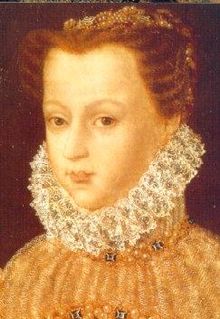
Portrait of Catherine de Medici as a child
Catherine was born on April 13, 1519 in Italian city Florence, center of the Florentine Republic. Full name at birth - Catherine Maria Romula di Lorenzo de' Medici. The Medici family actually ruled Florence at the time: originally bankers, they came to great wealth and power by financing European monarchies. Catherine's father - Lorenzo II di Piero de' Medici, Duke of Urbino (September 12, 1492 - May 4, 1519) - was not originally the Duke of Urbino and became so thanks to his uncle - Giovanni Medici, Pope Leo X. The title returned to Francesco Rovere after the death of Lorenzo. Thus, despite the ducal title, Catherine was of relatively low birth. However, her mother is Madeleine de la Tour, Countess of Auvergne ( OK. 1500 - April 28, 1519) - belonged to one of the most famous and ancient French noble families, which greatly contributed to Catherine's future marriage.
According to the chronicler, the parents were very happy about the birth of their daughter, they “were as pleased as if it were a son.” However, both soon die: Madeleine - on April 28 from childbed fever, Lorenzo - on May 4, having outlived his wife by only six days. The young couple had married the year before in Amboise as a symbol of the alliance between King Francis I of France and Pope Leo X against the Holy Roman Emperor Maximilian I. Francis wanted to take Catherine to be raised at the French court, but Leo X had other plans. He intended to marry her to his brother's illegitimate son, Ippolito de' Medici, and make them rulers of Florence.
After this, the newborn was cared for by her grandmother Alfonsina Orsini until her death in 1520.
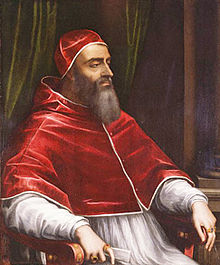
G. Medici, Pope Clement VII
Catherine was raised by her aunt, Clarissa Strozzi, along with her children, whom Catherine loved as siblings all her life. One of them, Pietro Strozzi, rose to the rank of marshal's baton in the French service.
The death of Pope Leo X in 1521 led to a break in Medici power on the Holy See until Cardinal Giulio de' Medici became Clement VII in 1523. In 1527, the Medici in Florence were overthrown, and Catherine became a hostage. Clement was forced to recognize and crown Charles of Habsburg as Holy Roman Emperor in exchange for his help in recapturing Florence and freeing the young duchess.
In October 1529, the troops of Charles V besieged Florence. During the siege, there were calls and threats to kill Catherine and hang her on the city gates or send her to a brothel to dishonor her. Although the city resisted the siege, on August 12, 1530, famine and plague forced Florence to surrender.
Clement met Catherine in Rome with tears in his eyes. It was then that he began to search for a groom for her, considering many options, but when in 1531 the French king Francis I proposed the candidacy of his second son Henry, Clement immediately jumped at the chance: the young Duke of Orleans was the most profitable match for his niece Catherine .
France
Wedding
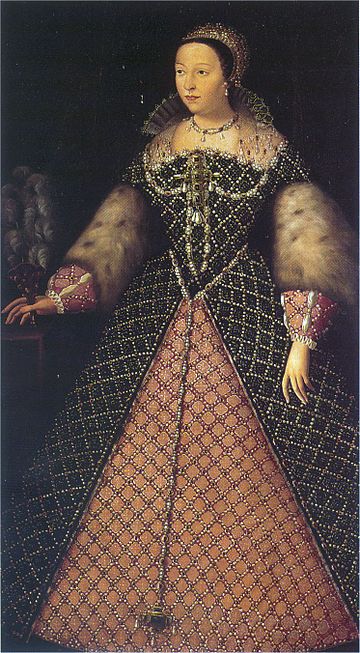
Catherine de' Medici
At the age of 14, Catherine became the bride of the French Prince Henry de Valois, the future King of France, Henry II. Her dowry amounted to 130,000 ducats and extensive possessions that included Pisa, Livorno and Parma.
Catherine could not be called beautiful. At the time of her arrival in Rome, one Venetian ambassador described her as "red-haired, short and thin, but with expressive eyes" - a typical appearance of the Medici family. But Catherine managed to impress the sophisticated French court, spoiled by luxury, by turning to the help of one of the most famous Florentine craftsmen, who made high-heeled shoes for the young bride. Her appearance at the French court caused a sensation. The wedding, which took place in Marseilles on October 28, 1533, was a major event marked by extravagance and the distribution of gifts. Europe has not seen such a gathering of the highest clergy for a long time. Pope Clement VII himself attended the ceremony, accompanied by many cardinals. The fourteen-year-old newlyweds left the celebration at midnight to attend to their wedding duties. After the wedding, 34 days of continuous feasts and balls followed. At the wedding feast, Italian chefs introduced the French court to a new dessert made from fruit and ice - this was the first ice cream.
At the French court
On September 25, 1534, Clement VII died unexpectedly. Paul III, who replaced him, dissolved the alliance with France and refused to pay Catherine's dowry. Catherine's political value suddenly disappeared, thereby worsening her position in an unfamiliar country. King Francis complained that “the girl came to me completely naked.”
Catherine, born in merchant Florence, where her parents were not concerned with giving their offspring a comprehensive education, had a very difficult time at the sophisticated French court. She felt like an ignorant person who did not know how to elegantly construct phrases and made many mistakes in her letters. We must not forget that French was not her native language, she spoke with an accent, and although she spoke quite clearly, the ladies of the court contemptuously pretended that they did not understand her well. Catherine was isolated from society and suffered from loneliness and hostility from the French, who arrogantly called her “Italian” and “merchant’s wife.”
In 1536, the eighteen-year-old Dauphin Francis unexpectedly died, and Catherine's husband became heir to the French throne. Now Catherine had to worry about the future of the throne. The death of his brother-in-law marked the beginning of speculation about the involvement of the Florentine woman in his poisoning for the quick accession of “Catherine the Poisoner” to the French throne. According to the official version, the Dauphin died of a cold; nevertheless, the courtier, the Italian Count of Montecuccoli, who gave him a cup of cold water, inflamed by gambling, was executed.
Birth of children
The birth of an illegitimate child to her husband in 1537 confirmed rumors about Catherine’s infertility. Many advised the king to annul the marriage. Under pressure from her husband, who wanted to consolidate her position with the birth of an heir, Catherine was treated for a long time and in vain by various magicians and healers with one single goal - to get pregnant. Every possible means was used to achieve successful conception, including drinking mule urine and wearing cow dung and deer antlers on the lower abdomen.
Finally, on January 20, 1544, Catherine gave birth to a son. The boy was named Francis in honor of his grandfather, the reigning king (he even shed tears of happiness when he learned about this). After her first pregnancy, Catherine seemed to no longer have problems conceiving. With the birth of several more heirs, Catherine strengthened her position at the French court. The long-term future of the Valois dynasty seemed assured.
The sudden miraculous cure for infertility is associated with the famous doctor, alchemist, astrologer and fortuneteller Michel Nostradamus, one of the few who were part of Catherine’s close circle of confidants.
Henry often played with children and was even present at their birth. In 1556, during her next birth, surgeons saved Catherine from death by breaking off the legs of one of the twins, Jeanne, who lay dead in her mother’s womb for six hours. However, the second girl, Victoria, was destined to live only six weeks. In connection with this birth, which was very difficult and almost caused the death of Catherine, doctors advised the royal couple not to think about having new children anymore; After this advice, Henry stopped visiting his wife's bedroom, spending all his free time with his favorite Diane de Poitiers.
Diane de Poitiers
Main article: Diane de Poitiers
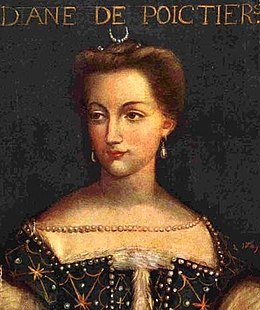
Diane de Poitiers
Back in 1538, the thirty-nine-year-old beautiful widow Diana captivated the heart of the nineteen-year-old heir to the throne, Henry of Orleans, which over time allowed her to become an extremely influential person, as well as (in the opinion of many) the true ruler of the state. In 1547, Henry spent a third of every day with Diana. Having become king, he gave his beloved the castle of Chenonceau. This made it clear to everyone that Diana had completely taken the place of Catherine, who, in turn, was forced to endure her husband’s beloved. She, like a real Medici, even managed to overcome herself, humble her pride, and win over her husband’s influential favorite. Diana was very pleased that Henry was married to a woman who preferred not to interfere and turned a blind eye to everything.
Queen of France
On March 31, 1547, Francis I died and Henry II ascended the throne. Catherine became Queen of France. The coronation took place in the Basilica of Saint-Denis in June 1549.
During his reign, his wife Catherine had only minimal influence on the administration of the kingdom. Even in Henry's absence, her power was very limited. In early April 1559, Henry II signed the peace treaty of Cateau-Cambresis, ending the long wars between France, Italy and England. The agreement was strengthened by the engagement of Catherine and Henry's fourteen-year-old daughter, Princess Elizabeth, to thirty-two-year-old Philip II of Spain.
Death of Henry II
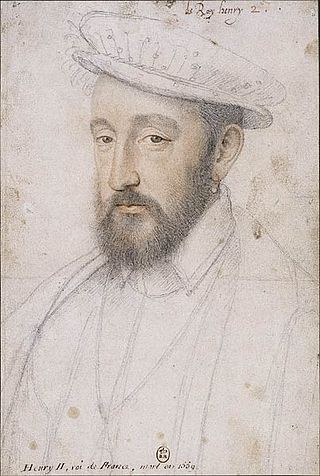
Henry II, (Francois Clouet, OK. 1553 G.)
Challenging the prediction of the astrologer Luca Gorico, who advised him to refrain from tournaments, paying attention specifically to the king’s forty-year-old age, Henry decided to participate in the competition. On June 30 or July 1, 1559, he took part in a duel with the lieutenant of his Scots guard, Earl Gabriel de Montgomery. Montgomery's split spear passed through the slot of the king's helmet. Through Henry's eye, the tree entered the brain, mortally wounding the monarch. The king was taken to the castle de Tournel, where the remaining fragments of the ill-fated spear were removed from his face. The best doctors in the kingdom fought for Henry's life. Catherine was at her husband's bedside all the time, and Diana did not appear, probably for fear of being sent away by the queen. From time to time, Henry even felt well enough to dictate letters and listen to music, but he soon became blind and lost his speech.
Black queen
Henry II died on July 10, 1559. From that day on, Catherine chose as her emblem a broken spear with the inscription “ Lacrymae hinc, hinc dolor» (« this is the reason for all my tears and my pain") and until the end of her days she wore black clothes as a sign of mourning. She was the first to wear black mourning. Before this, in medieval France, mourning was white.
Despite everything, Catherine adored her husband. " I loved him so much...", she wrote to her daughter Elizabeth after Henry's death. Catherine de Medici mourned for her husband for thirty years and went down in French history under the name “The Black Queen.”
Regency
Her eldest son, fifteen-year-old Francis II, became the King of France. Catherine took up state affairs, made political decisions, and exercised control over the Royal Council. However, Catherine never ruled the entire country, which was in chaos and on the brink of civil war. Many parts of France were virtually dominated by local nobles. The complex tasks that Catherine faced were confusing and to some extent difficult for her to understand. She called on religious leaders on both sides to engage in dialogue to resolve their doctrinal differences. Despite her optimism, the "Conference of Poissy" ended in failure on October 13, 1561, dissolving itself without the queen's permission. Catherine's point of view on religious issues was naive because she saw the religious schism from a political perspective. “She underestimated the power of religious conviction, imagining that all would be well if only she could persuade both parties to agree.”
Francis II died in Orleans shortly before his 17th birthday from a brain abscess caused by an ear infection. He had no children, and his 10-year-old brother Charles IX ascended the throne.
Queen Mother
Charles IX
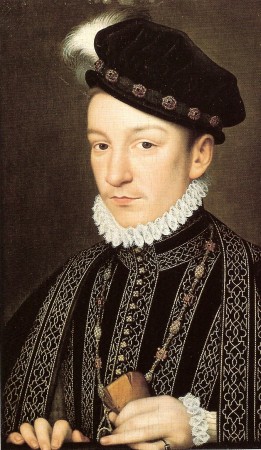
Charles IX, portrait Francois Clouet
On August 17, 1563, Catherine de Medici's second son, Charles IX, was declared an adult. He was never able to govern the state on his own and showed minimal interest in state affairs. Karl was also prone to hysterics, which over time turned into outbursts of rage. He suffered from shortness of breath - a sign of tuberculosis, which ultimately brought him to the grave.
Dynastic marriages
Through dynastic marriages, Catherine sought to expand and strengthen the interests of the House of Valois. In 1570, Charles was married to the daughter of Emperor Maximilian II, Elizabeth. Catherine tried to marry one of her younger sons to Elizabeth of England.
She also did not forget about her youngest daughter Margarita, whom she saw as the bride of the again widowed Philip II of Spain. However, soon Catherine had plans to unite the Bourbons and Valois through the marriage of Margaret and Henry of Navarre. However, Marguerite encouraged the attention of Henry of Guise, son of the late Duke François of Guise. The escaped Henry of Guise hastily married Catherine of Cleves, which restored the favor of the French court towards him. Perhaps it was this incident that caused the split between Catherine and Giza.
Between 1571 and 1573, Catherine persistently tried to win over the mother of Henry of Navarre, Queen Jeanne. When in another letter Catherine expressed a desire to see her children, promising not to harm them, Jeanne d'Albret jokingly replied: “Forgive me if, reading this, I want to laugh, because you want to free me from fears that I never Did not have. I never thought that, as they say, you eat small children.” Ultimately, Joan agreed to a marriage between her son Henry and Margaret, with the condition that Henry would continue to adhere to the Huguenot faith. Shortly after arriving in Paris to prepare for the wedding, forty-four-year-old Jeanne fell ill and died.
Massacre in Paris, St. Bartholomew's Night, Giorgio Vasari, 1572-1573 gg.
The Huguenots were quick to accuse Catherine of killing Jeanne with poisoned gloves. The wedding of Henry of Navarre and Margaret of Valois took place on August 18, 1572 at Notre Dame Cathedral.
Three days later, one of the Huguenot leaders, Admiral Gaspard Coligny, on his way from the Louvre, was wounded in the arm by a shot from the window of a nearby building. A smoking arquebus was left in the window, but the shooter managed to escape. Coligny was carried to his apartment, where surgeon Ambroise Paré removed the bullet from his elbow and amputated one of his fingers. Catherine was said to have reacted to this incident without emotion. She visited Coligny and tearfully promised to find and punish her attacker. Many historians blamed Catherine for the attack on Coligny. Others point to the de Guise family or to a Spanish-papal conspiracy that tried to end Coligny's influence over the king.
St. Bartholomew's Night
Main article: St. Bartholomew's Night
The name of Catherine de Medici is associated with one of the bloodiest events in the history of France - St. Bartholomew's Night. The massacre, which began two days later, tarnished Catherine's reputation. There is no doubt that she was behind the decision on August 23, when Charles IX ordered: “Then kill them all, kill them all!”
The train of thought was clear, Catherine and her Italian advisers (Albert de Gondi, Lodovico Gonzaga, Marquis de Villars) expected a Huguenot uprising after the assassination attempt on Coligny, so they decided to strike first and destroy the Huguenot leaders who came to Paris for the wedding of Margaret of Valois and Henry Navarre. Most likely it was an adventure of the Guise family, only it was important for them that religious world did not occur in France. The St. Bartholomew massacre began in the first hours of August 24, 1572.
The king's guards burst into Coligny's bedroom, killed him and threw his body out of the window. At the same time, the sound of the church bell was a conventional sign for the beginning of the murders of the Huguenot leaders, most of whom died in their own beds. The king's newly minted son-in-law, Henry of Navarre, was faced with a choice between death, life imprisonment and conversion to Catholicism. He decided to become a Catholic, after which he was asked to stay in the room for his own safety. All the Huguenots inside and outside the Louvre were killed, and those who managed to escape into the street were shot by the royal riflemen who were waiting for them. The Parisian massacre continued for almost a week, spreading across many provinces of France, where indiscriminate killings continued. According to historian Jules Michelet, " St. Bartholomew's Night was not a night, but a whole season" This massacre delighted Catholic Europe, Catherine outwardly enjoyed the praise because she preferred that foreign rulers think of the strong power of the Valois family. From this time on, the “black legend” of Catherine, the evil Italian queen, began.
Huguenot writers branded Catherine as a treacherous Italian who followed Machiavelli's advice" kill all enemies with one hit" Despite accusations from contemporaries of planning a massacre, some historians do not entirely agree with this. There is no hard evidence that the killings were pre-planned. Many view the massacre as a "surgical strike" that got out of control. Whatever the reasons for the bloodshed, historian Nicholas Sutherland has called St. Bartholomew's Night in Paris and its subsequent development "one of the most controversial events in modern history."
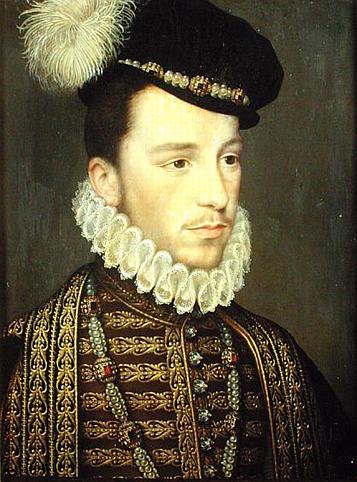
Henry, Duke of Anjou, around 1573, Jean Decorte. Henry's interest in governing the kingdom was not constant. From a letter from Henry III, 1583: “While I am with the Capuchins, and if there are any urgent and important matters ... you, and others, should apply to the queen with this, and not send for me.”
Henry III
Two years later, with the death of twenty-three-year-old Charles IX, Catherine faced a new crisis. The dying words of Catherine’s dying son were: “Oh, my mother...”. The day before his death, he appointed his mother as regent, since his brother, the heir to the French throne, the Duke of Anjou, was in Poland, becoming its king. In her letter to Henry, Catherine wrote: “I am heartbroken... My only consolation is to see you here soon, as your kingdom requires and in good health, because if I lose you too, I will bury myself alive with you.”
Favorite son
Henry was Catherine's favorite son. Unlike his brothers, he took the throne as an adult. He was the healthiest of all, although he also had weak lungs and suffered from constant fatigue. Catherine could not control Henry the way she did with Charles. Her role during Henry's reign was that of a state executive and traveling diplomat. She traveled the length and breadth of the kingdom, strengthening the king's power and preventing war. In 1578, Catherine again took upon herself the restoration of peace in the south of the country. At the age of fifty-nine, she undertook an eighteen-month tour of the south of France, meeting with Huguenot leaders there. She suffered from catarrh and rheumatism, but her main concern was Heinrich. When he suffered an ear abscess similar to the one that killed Francis II, Catherine was beside herself with worry. After she heard the news of his successful recovery, she wrote in one letter: “I believe God has taken pity on me. Seeing my suffering from the loss of my husband and children, he did not want to completely crush me by taking that away from me... This terrible pain is disgusting, believe me, to be far from the one you love the way I love him, and knowing that that he is sick; it’s like dying over a slow fire.”
Francois, Duke of Alençon
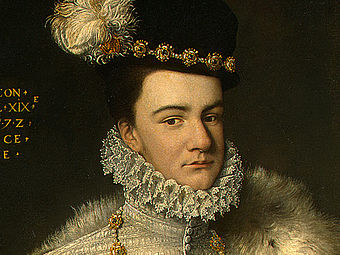
Hercule François de Valois, Duke of Alençon- the youngest son of Catherine de Medici. (Nicholas Hilliard c. 1577) Elizabeth of England called him "her little frog", although later, contrary to her expectations, she found him "not so ugly"
During the reign of Henry III, civil wars in France often descended into anarchy, maintained by the struggle for power between the high nobility of France on the one hand and the clergy on the other. A new destabilizing component in the kingdom was the youngest son of Catherine de Medici - Francois, Duke of Alençon, who at that time bore the title "Monsignor" (French. "Monsieur"). François plotted to seize the throne while Henry was in Poland, and later continued to disrupt the peace of the kingdom at every opportunity. The brothers hated each other. Since Henry had no children, Francois was the legal heir to the throne. Once Catherine had to lecture him for six hours about his, Francois, behavior. But the ambitions of the Duke of Alençon (later of Anjou) brought him closer to misfortune. His ill-equipped campaign in the Netherlands and the king's promised but unfulfilled aid in January 1583 ended with the destruction of his army in Antwerp. Antwerp marked the end of François's military career.
Another blow befell him when Elizabeth I officially broke off her engagement to him after the Antwerp massacre. On June 10, 1584, François died of exhaustion after failures in the Netherlands. The day after her son’s death, Catherine wrote: “I am so unhappy living long enough to see so many people die before me, although I understand that God’s will must be obeyed, that He owns everything and what He lends to us is only as long as He loves the children He gives us.” The death of Catherine's youngest son was a real disaster for her dynastic plans. Henry III had no children, and it seemed unlikely that he would ever have any, due to Louise de Vaudemont's inability to conceive a child. According to the Salic Law, the former Huguenot Henry of Bourbon, King of Navarre, became the heir to the French crown.
Marguerite de Valois
The behavior of Catherine's youngest daughter, Marguerite de Valois, annoyed her mother just as much as Francois's behavior. One day in 1575, Catherine yelled at Margarita because of rumors that she had a lover. Another time, the king even sent people to kill Margarita’s beloved Count de La Mole (a subject of François Alençon), but he managed to escape, and was later executed on charges of treason. La Mole himself revealed the conspiracy to Catherine. In 1576, Henry accused Margaret of having an inappropriate relationship with a lady of the court. Later in her memoirs, Margarita claimed that if it were not for Catherine’s help, Henry would have killed her. In 1582, Margarita returned to the French court without her husband and soon began to behave very scandalously, changing lovers. Catherine had to resort to the help of the ambassador to pacify Henry of Bourbon and return Margaret to Navarre. She reminded her daughter that her own behavior as a wife was impeccable, despite all the provocations. But Margarita was unable to follow her mother's advice. In 1585, after Margaret was rumored to have tried to poison her husband and shot him, she fled Navarre again. This time she headed to her own Agen, from where she soon asked her mother for money, which she received in an amount sufficient for food. However, soon she and her next lover, persecuted by the inhabitants of Agen, had to move to the Karlat fortress. Catherine asked Henry to take immediate action before Margaret disgraced them again. In October 1586, Margarita was locked in the castle d'Usson. Margarita's lover was executed before her eyes. Catherine excluded her daughter from her will and never saw her again.
Effigies of Catherine de Medici and Henry II, Abbey of Saint-Denis.Catherine de' Medici died in Blois on January 5, 1589, at the age of sixty-nine. An autopsy revealed a terrible general condition of the lungs with a purulent abscess on the left side. According to modern researchers, the possible cause of death of Catherine de Medici was pleurisy. “Those who were close to her believed that her life was shortened by frustration because of the actions of her son,” believed one of the chroniclers. Since Paris was held by enemies of the crown at that time, they decided to bury Catherine in Blois. She was later reburied in the Parisian Abbey of Saint-Denis. In 1793, during the French Revolution, a revolutionary crowd threw her remains, as well as the remains of all French kings and queens, into a common grave.
Eight months after Catherine's death, everything that she so strived for and dreamed of during her life was reduced to zero when the religious fanatic monk Jacques Clement stabbed to death her beloved son and the last Valois, Henry III.
It is interesting to note that of all 10 children of Catherine, only Margarita lived long enough long life- 62 years old. Heinrich did not live to see 40, and the rest of the children did not even live to see 30.
Influence of Catherine de' Medici
Some modern historians forgive Catherine de Medici for not always humane solutions to problems during her reign. Professor R. D. Knecht points out that the justification for her ruthless policies can be found in her own letters. Catherine de Medici's policies can be seen as a series of desperate attempts to keep the monarchy and the Valois dynasty on the throne at any cost. It can be argued that without Catherine, her sons would never have retained power, which is why the period of their reign is often called “the years of Catherine de Medici.”
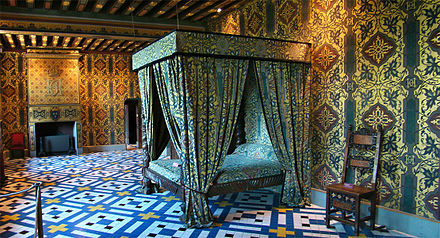
Room at the Château de Blois where Catherine de Medici died
During her life, Catherine inadvertently had enormous influence in fashion, outlawing the use of thick bodices in 1550. The ban applied to all visitors to the royal court. For nearly 350 years after this, women wore laced corsets made from whalebone or metal to narrow their waists as much as possible. With her passions, manners and taste, love for art, splendor and luxury, Catherine was a true Medici. Her collection consisted of 476 paintings, mainly portraits, and is currently part of the Louvre collection. She was also one of the "influential people in culinary history." Her banquets at the Palace of Fontainebleau in 1564 were renowned for their splendor. Catherine was also well versed in architecture: the Valois chapel in Saint-Denis, the addition to the Chenonceau castle near Blois, etc. She discussed the plan and decoration his Tuileries Palace. The popularity of ballet in France is also associated with Catherine de Medici, who brought this form performing arts with me from Italy.
Her contemporary, the famous French humanist and thinker Jean Bodin, wrote about her royal reign:
| “If the sovereign is weak and angry, then he creates tyranny, if he is cruel, he will organize a massacre, if he is dissolved, he will set up a brothel, if he is greedy, he will skin his subjects, if he is indomitable, he will suck out the blood and brains. But the most terrible danger is the intellectual unfitness of the sovereign.” |
This is how he, a contemporary, described his ruler, believing that the excessive cruelty of sovereigns is not a sign of strength, but a sign of weakness and “intellectual unfitness.”




